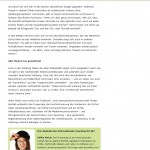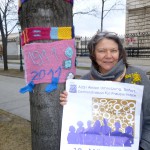Author Archive: Lena
How to Play a Feminist
Shira Chess
Introduction: Feminisms Dont Play
This is not an essay about women. This is an essay about gender, about equality, and about the politics and power of play. More importantly, this essay is about feminisms.
Because feminisms dont play.
Feminisms work. And then work more. Feminist work is occupied with womens rights: in homes and in offices, with bodies, with technology, with health, and with politics. The feminisms of the past three hundred years have all been inextricably entangled with these matters of gravity and importance. As such, there has been no playtime in feminism. And why should there be: why would a series of serious social movements have time to concern themselves with feminine play or playful activism?
But it is time for a playful (and play-filled!) feminism.
In Gender Trouble, Judith Butler debates the political problematics of making women the subject of feminism. She asserts:
The juridical formation of language and politics that represents women as „the subject“ of feminism is itself a discursive formation and effect of a given version of representational politics. And the very feminist subject turns out to be discursively constituted by the very political system that is supposed to facilitate its emancipation. (4)
I would like to suggest that the politics of play is (a small) part of this complicated relationship between women and feminism. In the past, unfair representations of women as frivolous have created feminisms that often resist play. Of course, in reality, women are not, by and large, unplayful. Instead, representations of feminisms are often unplayful and limiting.
Being playful has power: it is infectious, unifying, and gratifying. As such, play can be a tool, a source of agency for feminists and activists to drive forward a sometimes stagnating political movement that has been trapped in cycles of serious self-importance, a work-obsessed feminism that often forgets the value of frivolity. My analysis hinges on a complicated relationship between feminism and play. In this relationship, authorized forms of feminine play are often marginalizing, and at the same time often decoded as „frivolity.“ This image of feminine frivolity is something feminisms have been trying to evade for hundreds of yearsand, thus, feminism and play are often at odds with one another. Theoretical aspects of masculine styles of leisure and play are often at odds with feminisms. This is further complicated when past feminisms responded negatively to playfulness, discouraging what is interpreted as behaving frivolously. Ultimately, I offer ideas about the value of more playful feminismsboth as an activist movement and as a cause unto itself. Admittedly, there is an inescapable cultural bias to my analysis of play, leisure, and feminisms. This essay does not seek to impose my cultural bias on the play styles of the world but, rather, open conversations to how we understand play, femininity, and (of course) feminisms.
I envision a feminism of play that has two primary goals. First, a playful feminism can be an advocate for feminine playsomething currently sorely lacking. Second, I see play as a potential tool to reignite activism in the feminist community. While these two things are very different, they emerge from the same core: both are affected by a dearth of feminine play. Ultimately, I propose that locating and embracing feminine play can help to engender better conversations about leisure and equality, and a better means to have that conversation.
Consumerism, Play, and Femininity: How About a Nice Shopping Game?
As I do not wish to be essentializing, I make no assumptions about how individual women choose to play. Instead, my focus is on gendered assumptions about feminine play and masculine play. And while individual play styles may vary wildly, feminine play styles do not. In turn, cultural assumptions about feminine styles of play naturally become enfolded into expectations of how women are expected to play. While feminism may not (as Butler suggests) be about women, and while femininity might not always map to women, these things easily become tautological loops of essentializations.
An example from my own experience will serve as an example of this. My academic research in gender and video games has often led me to use my mother as a guinea pig (as a captive audience; she often has no choice!). Like many other baby boomer women, she has never expressed any interest in video games and one day, in my frustration with her total indifference, I finally blurted out, What kind of video game would make you want to play?
She paused. How about a nice shopping game? she asked, earnestly.
I wanted to be surprised by this remark, but I wasnt. I realized that in the three-plus decades I had spent getting to know my mother, shopping was how we most often spent time together. For instance, when I, or my cousins, or her sister, would come for a visit, we would ritualistically scoop up my grandmother so that three generations of women could go wandering around the shopping mall looking for bargains at Macys, trying on lipsticks, and eating at the food court. This realization was unsettling, and yet I knew that my experiences of shopping-as-play were in no way unusual. Cultural assumptions of feminine shopping as play and sport are constant and consistent in the American cultural landscape. This is not to say that I am condemning consumerism or women for taking a part in it. It would be hypocritical of me to suggest that I am at all above sneaking away to Target for my play breaks from work.
But the more I thought about this comment, the more uneasy I became. Seeking another opinion, I mentioned this to a colleague. A shopping game? Wouldnt that be E-bay? she pithily replied. Indeed, I realized that gendered digital play, from video games to the internet, often takes on this consumerist guise. I soon became attuned to the word „play“ and its uses in feminine spaces. I found it often in cosmetics and skincare departments, and in advertisements promoting gigantic sales where women could go on shopping sprees. Within assumptions about femininity and generalizations about women, play is often inextricably linked to shopping and consumerism. And while masculinity is certainly not excluded from the shopping-as-play paradigm, there is an overabundance of stereotypes involving femininity, leisure, and shopping. On several occasions women have confessed to me a great distaste for the shopping rituals of Western femininity, but then almost always quickly add that they feel that not enjoying shopping makes them less feminine. To a similar end, men that I know that enjoy shopping often confess embarrassment of enjoying this supposedly feminine pastime.
Such anxieties are also often reflected in feminist thought. In Where the Girls Are, Susan Douglas discusses the complicated relationship, as it is perceived by many feminists, between women and shopping. Douglas suggests that advertising and media in the 1980s (and beyond) used feminist rhetoric to promote beauty and shopping to women. According to Douglas, advertisements commonly suggested that:
The ability to spend time and money on ones appearance was a sign of personal success and of breaking away from the old roles and rules that had held women down in the past. Break free from those old conventions, the ads urged, and get truly liberated: put yourself first. (246, original emphasis)
Similarly, associations between feminine consumerism and leisure are an unsurprising, and by no means new, area of scholarship. Shopping as leisure is a highly constructed category that has influenced (and been influenced by) our consumerist culture for over a century. For example, A. Fuat Firat writes of women and consumerism:
The femalespecifically, in visual culture, the female bodybecame the representation of the feminine, which was the ideal consumer in Western culture. She went shopping while he worked. She spent his money or earnings. Her frivolity in buying and consuming became a major topic of jokes in the culture. She was such a consumer that he had always to restrain her appetite for consumables. (210, my emphasis)
In other words, my mother is not alone. In Western culture, shopping is constantly represented as an allowable form of feminine leisure. Firats remark about the „frivolity“ perceived in shopping-as-leisure is notableit mirrors deeper implications about who is allowed to play in what ways, by gendered standards. It would seem that consumerism is one of the most sanctioned feminine forms of play, and yet it is economically marginalizing as an integral part of consumer culture.
To some extent, this obsession with shopping can be understood in terms of Althussers definition of interpellation. According to Althusser, individuals have a distinct relationship with ideologies. He suggests that individuals are hailed by ideologies, which (in turn) makes them a subject of that ideology. Althusser contends that while individuals are always-already subjects of their ideologies (84), being hailed involves a moment of recognition. Althusser illustrates:
There are individuals walking along. Somewhere (usually behind them) the hail rings out: „Hey, you there!“ One individual (nine times out of ten it is the right one) turns round, believing/suspecting/knowing that in reality these things happen without any succession. The existence of ideology and the hailing or interpellation of individuals as subjects are one and the same thing. (86)
In effect, Althusser is suggesting that the interpellation process is thoughtless and immediatethe Hey You is automatically interpellated and thus becomes part of how subjects understand themselves. In Bodies that Matter, Judith Butler takes Althussers interpellation a step further by suggesting that gender itself is interpellated. She relates this back to the moment of being born, when it is declared, Its a girl! or Its a boy! She explains:
Consider the medical interpellation which (the recent emergence of the sonogram notwithstanding) shifts an infant from an „it“ to a „she“ or a „he,“ and in the naming, the girl is „girled,“ brought into the domain of language and kinship through the interpellation of gender. But that „girling“ of the girl does not end there; on the contrary, that founding interpellation is reiterated by various authorities and throughout various intervals of time to reinforce or contest this naturalized effect. The naming is at once the setting of a boundary, and also the repeated inculcation of a norm. (7-8)
Thus, according to Butler, the interpellation of ideologies in general is simultaneously enfolded into the interpellation of gender ideologies. Just as the its a girl! moment helps the process of girling and constructs femininity in its always-already status, mass media and popular culture constantly reaffirm what it is to be a girl or a woman. And that process of interpellation can undeniably be said to include play practices.
If play can be understood as ideologically driven, then perhaps this gives us a clearer picture of how feminine play often turns into shopping and consumer culture. Just as there is an always-already expectation aligned with its a girl, later in life that same girl is always-already expected to treat shopping as a leisure activity. Of course, this is not to say that men do not shop, but media portrayals of masculine shopping and leisure are not nearly as embedded in the ideology of play. Along these lines, my mother could not possibly have thought of a video game other than a nice shopping game.
Masculinity, it seems, has more authorized, more important kinds of play, ruling domains such as sports and video gameswhat can be called agonistic play. For instance, in terms of video game play, both Henry Jenkins and Derek Burrill refer to typical video game play as masculinity par excellence. Burrill specifically discusses ways that video games are playgrounds for the construction and performance of masculinity or digital boyhood (2), arguing that the player is always already male (138). Similarly, research on gender and sports often focus on the inherent masculinity in sport culture. Michael Messner refers to sport as a contested terrain in terms of sex, but one often dominated by hegemonic masculinity, replete with its traditions of violence, sexism, homophobia, and militarism (4). Surely, these are not one-dimensional spaces and many women have found success in them, but by-and-large they are still governed by masculinity. As such, masculine play often involves gatherings of men playing and watching sports, or playing and watching video games. Agonistic playwhile competitivecomes from the Greek root which is slightly different from antagonism. It is about the camaraderie of competition. Whatever complaints one might have about steroid use in sports, or violence in video games, these things seem to be only by-products and anomalies. Masculinity, it seems, is permitted to define serious play, while femininity is relegated the aforementioned category of frivolousness
Of course, agonism is not the only kind of playbut it is certainly a form of play that is given weight and importance. What is essentialized as feminine play is often typified as frivolous: flirtation, gossip, and (of course) shopping. In Firats quote from above, she uses the word frivolity to describe what is often interpreted as womens obsession with shopping as leisure. This word is an important one, and I will later show how it has haunted feminist rhetoric for hundreds of years. Interpellations of women in terms of shopping and beauty often maps to feminist fears that women wont be taken seriously, and instead be seen as purely frivolous. But frivolity has its place. In Brian Sutton-Smiths The Ambiguity of Play, he writes of frivolity: No theory of play would be adequate if it did not leave scope for its own deconstruction and distortion into nonsense. Any earnest definition of play has to be haunted by the possibility that playful enjoinders will render it invalid (213). According to Sutton-Smith frivolity is the tool that will help us to better understand the core nature of play. So it isnt that women are stereotyped as never playing at all; but rather that their play is often taken less seriously. Feminisms (as I will explore later) are often portrayed as being entirely averse to play.
Defining Play and Leisure: Playing with Play
Johan Huizinga, one of the most prolific sociologists to ever write about play and games, wrote in Homo Ludens that play is a significant function of human life, and that Play cannot be denied. You can deny, if you like, nearly all abstractions: justice, beauty, truth, goodness, mind, God. You can deny seriousness, but not play (3). If what Huizinga says is true, if play is a significant, undeniable, and vital function of human life, then it is important to examine it. And, if what I propose is true, if femininity is at odds with this significant function, then there is a serious problem with frivolous repercussions (or vice versa!). Further, if femininity has such an ambivalent relationship with play, then we must ask how this has ultimately affected feminist thoughtboth in terms of advocating leisure and as a means of activism.
But what do I mean by „play“?a term that I have been tossing about loosely (until now) in this essay. Play is very neatly and cleanly defined by Katie Salen and Eric Zimmerman in their book Rules of Play as Free movement within a more rigid structure (304). While this definition might initially seem simplistic, it is its simplicity that allows it to be understood and negotiated into a variety of contexts. While their definition works for game-play, it also encompasses imaginative play, word play, and playing an instrument. The inherent tension between freedom and rigidity becomes the compelling part of this definition, and perhaps a useful means of understanding things that are not necessarily automatically understood as play. I will later return to the power of play and the usefulness of this broad definition in terms of feminist activism.
Leisure can be distinguished from play to a certain extent. Leisure studies (mostly housed in sociology) tend to define leisure either in comparison to work, or else in terms of „leisure industries.“ Leisure studies topics tend to focus on several areas of inquiry, although travel and sports studies are the most common. For the most part, leisure can be understood in terms of a persons free time activities and a state of mind that goes with them (Parr and Lashua). So, in many ways, leisure is similar to play but at a slightly larger scope. Play is an activity done in leisure timebut by its definition also implies more freedom than leisure.
Studies of women and how they spend their leisure time shed light on the larger issue of feminism and play. Leisure studies usually addresses the topic in terms of sexual difference: they consider how women spend their leisure time and the specific ways that this leisure time is often overwhelmed by non-leisure themes such as work, housework, and family. While, as I have already stated, my focus in this essay is on gender and feminism and not on womens specific practices, leisure studies is one of the only areas of inquiry that has paid any attention to feminine leisure practices. Thus, because feminism and femininity often map back to womens practices, these things all become inextricably linked. This essay is not about women, but in order to understand the tumultuous relationship between feminism and play it is necessary to examine the equally problematic relationship between women and play.
According to research on women and leisure, one of the key issues is time: either too much or not enough. With many women still juggling work and home life, in what Arlie Russell Hochschild refers to as the second shift, womens leisure often plays out in snippets of time: knitting, watching television, and shopping are frequently stereotyped feminine play activities. This kind of play never becomes fully immersive and is about wasting time and filling time, not necessarily about having real and full leisure time. Womens play is often also about making families happy: engaging in other peoples play.
In her recent essay Feminism and Leisure Studies, Rosemary Deem has rather neatly summarized the problem with women and leisure: while many feminist scholars have taken some note of an unequal leisure situation, it is difficult to know what to do with this information in order to correct it. Deem explains, There is much discussion about the importance [] of gender ideologies but little attempt to explore how these actually work in the field of leisure (265). This observation seems to be get to the heart of the problem. While feminisms have instigated dialogues about problems in work, home life, politics, and health, issues of leisure have not been treated with the same weight. And yet, the complicated relationship between femininity and play, I would like to suggest, is embedded in the past three hundred years of Western feminisms.
Historical Contexts: Feminisms and the Politics of Play
While all women are not necessarily feminists, and all feminists are not women, the tenuous relationship between femininity and play has often been mirrored by a tenuous relationship between feminism and play. As already noted, these tensions have often found form in rhetoric against „frivolity.“ Therefore, as frivolity has importance and value, it becomes essential to explore some of this rhetoric in order to better understand this complicated relationship between women, feminism, and play. My selection below highlights themes of feminine frivolity. This focus on frivolity (as opposed to play) was, in part, out of necessity. Showing examples of how something does not exist is a difficult task but, at the same time, there are patterns. I did not have to go far to find references to frivolity and felt that, in many ways, this concept contributed to a rhetoric that does not generally support leisure and play.
Many of the early feminists (such as Mary Wollstonecraft), through the American First Wave of feminism (the suffrage movement) and all the way through to Simone de Beauvoir, were trying to make women appear less frivolous. For example, in her Vindication on the Rights of Women, Wollstonecraft writes that men view women as a swarm of ephemeron triflers and that they are reckoned a frivolous sex. This sentiment (and resentment) continues through the writing of many early feminist figures with detrimental repercussions. Often frivolity was overtly eschewed in these discussions about womens rights. In order to show their equality to men, women overcompensated for frivolous reputations and downplayed play.
Later, these issues were echoed in the American suffragist movement. Because the primary issues for suffrage involved political and educational rights, many of the important speeches and writings of the period focused on intelligenceor rather, whether women had equal intelligence to men. For example, in the Declaration of Sentiments and Resolutions in 1848, Elizabeth Cady Stanton and her suffragist cohort said, Men, bless their innocence, are fond of representing themselves as beings of reason, of intellect, while women are mere creatures of affections (Stanton, 47). Similarly, in her Discourse on Women, Lucretia Mott explains:
The kind of homage that has been paid to women, the flattering appeals which have too long satisfied herappeals to her mere fancy and imagination, are giving place to a more extended recognition of her rights, her important duties and responsibilities in life. (74)
Thussimilar to WollstonecraftStanton, Mott, and other key members of the suffrage movement were primarily fighting a reputation that biologically designated them as frivolous: permanently incapable of making the adult decisions that men make. It was the driving need to combat this reputation of being emotional, frivolous, and childish that was essential to the womens movement of that time period. But, just as with Wollstonecraft, the negation of frivolity led to an eventual dissonance between feminisms, leisure, and play.
Admittedly, the leisure opportunities that were available to women in this period were only questionably playful. In her sociological study of American women (slightly before the suffragists), Harriet Martineau suggests that feminine leisure activities primarily served practical purposes and were ultimately shallow: As for the occupations with which American ladies fill up their leisure; what has already been said will show that there is no great weight or diversity of occupation (Martineau, 139). Thus, by Martineaus assessment, American women were just as limited in their leisure activities as they were in their working activities.
After the First Wave (and approaching the beginning of the Second), Simone de Beauvoir broaches these topics of play and leisure, but not in detail and primarily in reference to children. According to de Beauvoir, while boys are taught more competitive play styles from early childhood, girls are given play activities that initiate them into their destined sphere (281). Play and leisure for adult females does not particularly improve, either. Because womens leisure relies, in part, on the schedules of husbands and children, and must fit around the drudgery of housework or menial jobs, womens leisure time is more about wasting time and pleasing others. De Beauvoir describes the everyday plight of the married woman as constantly waiting for her husband to return home from work, only to be greeted by the disappointment it brings because of boredom and shallow intimacies. She writes, The evening is dull: reading, radio, desultory talks; each remains alone under cover of this intimacy. The wife wonders, with hope or apprehension, whether tonightat lastsomething will happen (475).While this discussion of leisure is notable (given the paucity of the topic in previous feminist rhetoric), she does not elaborate at great length or prescribe solutions.
More importantly, these remarks are not addressed by the Second Wave feminisms that were so deeply influenced by her. Rather, Second Wave feminisms largely abandoned this topic, focusing instead on serious causes: birth control, abortion, and advancing women in the workplace. And while these topics are all vital and necessary to furthering feminisms, they left little time for leisure: getting women into the workplace did not diminish their responsibilities at home, and so killed off any possible hope for promoting playtime. Feminist texts did not generally discuss women and leisure: they were too busy trying to get the serious stuff down
For example, in The Feminine Mystique, Betty Friedan explains that, post-suffrage, women were tricked by popular media back into a frivolous stance, pushing them to embody a mythological femininity as the happy housewife. She remarks, The image of women that emerges from this big, pretty, magazine is young and frivolous, almost childlike; fluffy and feminine; passive; gaily content in a world of bedroom and kitchen, sex, babies, and home (83). It seems that despite the hard work of the suffragists and other feminists in the early part of the twentieth century, Friedan shows that women were once again portrayed as childlike and frivolous. And, like her predecessors, Friedans call to arms involves dispelling this myth through career, through activism, and through stronger identity formation. But while these are logical and noble responses to being treated frivolously by men, there is no discussion (or understanding) by Friedan that frivolity might have its purpose too, in the form of play. As with previous feminist writing, Friedans depiction gets so caught up in the task of creating serious women that the identity formation of these women does not include room for play.
The one obvious exception to this would be the rhetoric supporting Title IX of the Education Amendments Act of 1972. This legislation is best known for seeking to give equal funding to womens sports, although it encompassed significantly larger territory than this.[1] While this struggle was important, the pro-Title IX rhetoric primarily advocated very specific kinds of play. A feminist stance regarding a right to play and leisure needs to be even broader, including women who both are and are not interested in sports.
Additionally, The Second Wave is notable for its use of playful tactics in activism. While this was not necessarily widespread, groups such as WITCH provided a more playful means of sending out a message. In the next section of this essay I will address play as activism, but for now it is important to note that even these groups did not necessarily advocate equal play as much as they advocated equal pay.
After the Second Wave, important voices such as Susan Faludi and Naomi Wolf continued to overlook play. Faludi, for example, fell into the trap of many of her predecessors, overcompensating for perceptions of feminine frivolity. Similarly, in Wolfs well-known book The Beauty Myth she takes on the seriousness of beauty, but does not recognize the problematic relationship between women and play within this equation, nor does she suggest alternative modes of beauty-related play. Ironically, she hits the nail on the head in her conclusion, asking:
Can there be a prowoman definition of beauty? Absolutely. What has been missing is play. The beauty myth is harmful and pompous and grave because so much, too much, depends upon it. The pleasure of playfulness is that it doesnt matter. Once you play for stakes of any amount, the game becomes a war game, or compulsive gambling. In the myth, it has been a game for life, for questionable love, for desperate and dishonest sexuality, and without the choice not to play by alien rules. No choice, no free will; no levity, no real game. (290)
Wolf is absolutely correct in these assertions but there are still two major problems within her observations. First, she does not recognize that the problematic relationship between women and play has contributed to this phenomenonthat women are using beauty as a form of play and that this deeply complicates an already complex problem. Second, she offers no real answer or solution to how women might go about finding this playful sense of beauty. In many ways, Wolf creates an impossible paradox for womenone that can be seen reflected in the nice shopping game remarks my mother made.
The Third Wave of feminism has touched on some of these issues, albeit often with mixed messages similar to those of the previous generations of feminists. In many ways, the Third Wave is about reclaiming individual narratives. In Jennifer Baumgerdner and Amy Richards Manifesta: Young Women, Feminism, and the Future, they suggest that it is attention to individual narratives that makes the Third Wave unique. They explain, On every Third Wave Foundation membership card, for example, there is a place that asks, My issues are?, and no two cards have ever listed the same answer (47). Because a broader number of stories are told in the Third Wave, the space becomes more feasible for more narratives (both playful and unplayful) to be told. At the same time, the play and leisure of women is not a subject that has been focused on to any large extent in recent years. Perhaps many feminists today still have a fear of not being taking seriouslymaybe not for the same reasons that Mary Wollstonecraft or the suffragists wrote of, but for new reasons that are just as pressing (for example, fighting media impressions that feminism is dead). The confluence of many voices in the Third Wave is ripe for discussions of equal play. Todays feminisms need to reclaim play as an important facet of life. As Sutton-Smith suggests in his writing about frivolity as a form of play, frivolity is a valuable means of understanding the very nature of play itself. Frivolity is important. Instead of seeing frivolity as a negative image for women, and damaging to the causes of feminism, feminists should embrace the nuances of frivolity, and advocate play for all. Next, I will show how play also has potential for new forms of activism.
A Free (Womens) Movement: Play as Activism
It seems only fair to ask how something as serious as feminismor any activist cause, for that mattercan be benefited by more playfulness. After all, wouldnt play and frivolity potentially only play down the seriousness of a cause? But play has power that exceeds its own boundariesit is free movement within a more rigid structure (Reference) and if we were to consider the hegemonies and patriarchies of Western culture, it would seem that the definition of play that I have chosen (the notion of getting to move about freely) is precisely what feminist activists hope to gain. Salen and Zimmermans definition becomes particularly salient and useful when play is combined with activism. In essence, play spaces can become staging areas for feminist activism. This is something that some groups began to experiment with in the Second Wave, and something sorely needed by todays feminist movements.
As already mentioned, perhaps the most playful period of feminist activism to date was during the Second Wave. Activist groups such as WITCH used what can be considered playful tactics to carry out serious messages. In Sporting with the Gods: The rhetoric of play and game in American culture, Michael Oriard suggests that many feminists of this era were indeed deeply entwined in playful philosophies through debates over sexuality and in a radical feminist utopian vision (481). He explains:
What unites these different concerns is their common emphasis on articulating and realizing womens desires, freed from patriarchal oppression. The rhetoric of play in these two contexts has tended to come from different groups within feminism: utopian play from radical essentialist. Play can embody a number of radical feminist ideas: nonseparation from nature, rejection of domination, celebration of the female body and of intuition and feeling. (481)
Indeed, protest-play such as the WITCH protest at the 1969 bridal show in Madison Square Garden had playful and performance-centric elements: activists set free mice, wore black veils, and chanted Here come the slaves, off to their graves (Echols 97-98). Creative protests such as these have the power to help people move beyond their typical ways of thinking. Similar protests include WITCHs hex on Wall Street as well as the famous protest at the Miss America Pageant of 1969.
However, this playful activism was only a small part of the Second Wave movement, and was not often replicated. Additionally, it was often and easily conflated with much harsher (and less successful) attempts at activism during that era. SCUM (or the Society for Cutting Up Men) most obviously sits at this boundary between playful and non-playful feminisms of this era. Valerie Solanis famous SCUM Manifesto articulates much of the second wave frustration. Solanis writes:
Life in this society being, at best, an utter bore and no aspect of society being at all relevant to women, there remains to civic-minded, responsible, thrill-seeking females only to overthrow the government, eliminate the money system, institute complete automation, and destroy the male sex. [] The male, because of his obsession to compensate for not being female combined with his inability to relate and feel compassion, has made the world a shitpile. (Solanis 514-515)
While this manifesto is to a large extent tongue-and-cheek, it simultaneously draws an unplayful line in the sand. Solanis SCUM Manifesto manages to be both playful and unplayful at the same timethe Manifesto rhetorically plays with (and turns around) past sexist assumptions to show its problematic nature, but at the same time appears unwavering and inherently morally superior. Further, one might even suggest that documents such as the SCUM Manifesto helped to carve an unplayful image of feminism (intentionally or otherwise) that filtered into future generations. Similarly, groups such as the radical feminist Cell 16 helped to construct non-playful images with their journal, No More Fun and Games. The message of abandoning play became an implicit part of how the public, the media, and many feminists themselves came to understand feminism. While the playfulness of WITCH may have been a useful tactic, the seriousness of groups such as SCUM and Cell 16 is the image that stuck. These small pockets of play that were found in the Second Wave were, in large part, unfortunately lost in most of the post-feminist voices of the early 1990s.
In WITCHs demonstrations, they created what I would characterize as a magic circle of play. Salen and Zimmerman use this idea, loosely borrowed from Huizinga, and they describe the magic circle as a play space where a player is able to enter, and subsequently work with different rules than that of everyday reality (95). In discussing these boundaries they explain:
As a closed circle, the space it circumscribes is enclosed and separate from the real world. As a marker of time, the magic circle is like a clock; it simultaneously represents a path with a beginning and end, but one without beginning and end. The magic circle inscribes a space that is repeatable, a space both limited and limitless. In short, a finite space with infinite possibility. (95)
There are numerous aspects to Salen and Zimmermans description of the magic circle that are strikingly relevant to my discussion of feminism(s) and their relationship to play. The magic circle is a space where participants are able to work with rules that are alternate to those they encounter in real life. By „stepping in“ to the magic circle, the players are neither complying entirely with their own rules nor are they simply obeying the rules of a game; there is a tacit agreement with the other players (or with themselves) that certain boundaries are to be maintained when existing in this alternate space. Thus, the space constructed by magic circles of play helps to create a staging area, where alternative rules and alternative realities are accepted and negotiated.
As already noted, the Third Wave emphasis on individual issues and narratives is particularly primed for playful feminist activism. One possible means of doing this might be through what is known as Alternate Reality Games (ARG). According to Jane McGonigal, an ARG is:
An interactive drama played out online and in real-world spaces, taking place over several weeks or months, in which dozens, hundreds, thousands of players come together online, form collaborative social networks, and work together to solve a mystery or problem that would be absolutely impossible to solve alone. (qtd in Jenkins 250)
While many ARGs have been part of marketing campaigns in order to promote forthcoming products, this collaborative and social form of play is ripe with activist potential. On a smaller scale, Katie Salens projects such as Karaoke Ice (a project where an ice cream truck had city dwellers sing publicly for their ice cream) or The Big Urban Game (where participants were asked to vote daily on the most efficient routes between changing checkpoints in a city) (Salen) could easily model playful activism for younger generations of feminists. These kinds of projects are ideal for getting new people involved and reinforcing communities. It is time for this kind of newer, activist play.
Play-as-activism is powerful because it can be overlooked by those who are not in the magic circleas a separate space it provides both freedom and privacy from the hegemonies that guide culture. Treating play as activism (and activism as play) can provide a powerful tool for feminists to push forward a cause that has lain stagnant for many years. Live public play spaces need to be constructed specifically for women to facilitate community, solidarity, and dialogue. These spaces can be non-serious, non-threatening and not already overrun by masculine play. With the growth of online gaming, these public spaces are opening up into virtual spaces, creating limitless possibilities for potential forms of playful activism. Virtual game worlds such as World of Warcraft and Second Life only begins to suggest the possibilities that are opening up through internet gaming.
Through play, feminist activism can find a new kind of power. The ambivalence of feminisms towards play has ultimately limited feminist causes. The seriousness and non-playful activist approaches have long given fodder to conservative pundits. Playful activism can begin to combat this image, and prove media depictions of stringent feminisms wrong. Play is power.
Conclusion: The Playful is Political
Playful does not mean dismissive. Frivolous does not mean ignorant. Embracing one of these things does not automatically mean being associated with the other. Instead, it means that, along with gravity and importance, we must embrace the ridiculousness and lightness of a cause. Along with work, we must make time for play. Play is not just for children: masculinity has long integrated play into the everyday and feminism needs to do the same (not through emulation but through experimentation).
Play can adopt two important roles within the feminist community. As I have demonstrated, it can be a means of activism and it can also take on a role of advocacy. If feminism, as an activist movement, uses more playful tactics then it is more in a position to advocate for feminine playa cause that (as I have demonstrated) is necessary and underrepresented. Feminist rhetorical style needs to mimic feminist causes (or, to put it simply, we must practice what we preach).
We cannot possibly know, yet, what feminine play might look like. My mother is looking for her nice shopping game.“ At the same time Bust magazine has been pushing the fiber arts of knitting, crocheting, and sewing. But the frag dolls, the riot grrls, and women in sports all have different ideas. And all of these carry the old essentializations and baggage of the past few hundred years of feminisms. My point is not that any of these acts of play are wrong but rather that Western feminists need to start examining play more carefully and examining how it can be used to subvert patriarchal norms, to promote equal rights, and to ignite new forms of activism.
Everyone knows that we live in a time of fractured feminisms. Through finding more feminine forms of play, and through embracing playful activism, feminism can make new headway. Play is unifying, powerful and strong, and although frivolous, play can have a purpose. Because the playful can be political too.
Feminism, Activism, and Knitting: Are the Fibre Arts a Viable Mode for Feminist Political Action?
Feminism, Activism, and Knitting: Are the Fibre Arts a Viable Mode for Feminist Political Action?
Beth Ann Pentney
Knitting and Feminism’s Third Wave
Domestic crafts such as knitting have experienced an upsurge in Western popular culture as of late. This point might be painfully obvious if you live in a medium-to-large-sized city in North America, where yarn shops have been springing up, or springing back to life, since the beginning of the twenty-first century, due partly to the popularity of the publication Stitch’n Bitch: The Knitters Handbook (Stoller 2003). This book, with its ironic tone and kitschy visuals, and the flurry of activity on the Internet (in the form of weblogs, websites, and netrings devoted to knitting) shed some light on the complicated relationship third-wave feminism has had with feminist politics and traditional femininity. Popular third-wave discourse, exemplified by Debbie Stoller, who is co-founder of the third-wave magazine Bust as well as author of Stitch’n Bitch, aims to celebrate and reclaim the domestic arts as a way to fuse fun with politics and her belief in women’s community building through do-it-yourself (DIY) culture.[1] Valuing the craft of knitting is a feminist act in itself according to Stoller, because the denigration of knitting correlates directly with the denigration of a traditionally women-centred activity (9). This type of reclamation has faced scrutiny from those who argue that the celebration of the domestic arts is neither politically effective nor feminist; rather, the resurgence in the popularity of knitting is merely an extension of a trend that supports individualistic, apolitical consumerism, as yarn prices certainly reflect a tendency to sell to upwardly mobile women with considerable disposable income. While I agree that the celebration or reclamation of a craft is not an end in itself, Stoller’s position warrants further examination, especially as it offers an avenue to examine what I call ‘feminist knitting practices,’ which include active and purposeful knitting projects used in the spirit of feminist goals of empowerment, social justice, and women’s community building.
I argue that contemporary third-wave feminism should be imagined as a practice. By doing so, different cultural practices can be utilized for feminist goals by people who may not readily identify as feminist. The advantage of casting a wider net over what ‘counts’ as feminism is that it recognizes that feminism is part of the contemporary North American social fabric, rather than a necessarily reactive political movement. Thus, thinking of feminism as a practice will help recuperate third-wave feminism, a movement that has been routinely lambasted by mainstream media and second-wave feminists for its failure to unite in large-scale political protest over issues of importance to women. Building upon the idea of feminism as a practice, I outline and provide examples of feminist knitting practices as they occur on a continuum. As I see it, a continuum model places different feminist knitting practices along a horizon that does not engender a hierarchical valuing of such practices. Instead, imagining feminist knitting practices along a continuum recognizes that while they may differ in tactics, scope, and purpose they nevertheless contribute to a feminist ethos. I begin with an examination of women’s community building and celebration of knitting as a domestic art (located at one end of the continuum), move into a consideration of outreach and fundraising activities such as those undertaken by Beryl Tsang and Stephanie Pearl-McPhee (located towards the middle of the continuum), and conclude with examples of knitting used in public forms of political protest, including rallies, marches, and public displays (located at the other end of the continuum). Although I envisage feminist knitting practices along a continuum, I also consider the problems associated with this model to determine what, and whom, has been omitted from feminist knitting practices and ways to address these omissions.
The question posed in the title of this article, Are the fibre arts a viable mode for feminist political action? can be answered in the affirmative if the term ‘feminism’ is expanded to include “a practice as well as a politics and a strong intellectual movement” (Gray 90, italics in original). Anne Gray’s expanded definition acknowledges the important place that ‘experience,’ which can be used to challenge truth-claims and taken-for-granted certainties that often marginalize and silence groups of people, occupies in feminism. The problem of identity politics that weighed down second-wave, liberal feminism and led to exclusivity and much subsequent criticism from lesbian women, poor women, ‘third world’ women, and black women can be overcome to some extent by envisaging feminism as a practice. Doing so allows for difference among feminists rather than assuming or demanding adherence to a specific subject position (in the case of second-wave, liberal feminists the subject position represented was predominantly white, heterosexual, educated, middle-class, and biologically female). Gray’s conception of feminism does not assume that there is a correct way to practise feminism; rather, it acknowledges that different practices can be taken up in the spirit and cause of feminism, and, in the process, feminism can be widened to embrace those who may not otherwise identify with the term. Knitting can be used for feminist goals because it is grounded in a gendered cultural practice that can readily be politicized for different purposes by different groups and individuals. Thus, when I refer to ‘feminist knitting practices’ within the context of this paper, I am referring to (1) knitters and knitting practices that explicitly acknowledge the gendered (feminine) associations with knitting and the historical devaluation of women’s handicraft and (2) knitting that is created within and for the goal of purposeful social change. In identifying and examining such practices, I hope to add some richness to the debates on the re-emergence of domestic arts in a feminist political context.
Part of what makes it difficult to outline clearly the connections between knitting, feminism, and activism is the existence of multiple and contradictory definitions of feminism, in both popular and academic circles. While it can be limiting to think of feminism occurring chronologically in ‘waves’ that exist completely, linearly, and separately from each other, it is important to recognize the economic and cultural advances some women have experienced as a result of second-wave feminism during the latter half of the twentieth century in North America and parts of Europe. Second-wave feminism encompasses many kinds of feminism but is popularly associated with the grassroots political activism that emerged in the 1960s alongside social justice movements such as the student movement, the anti-war movement, and the civil rights movement. Feminists fought for reproductive rights, abortion, pay equity, and equal opportunities in the workplace, and they interrogated the family as a system of oppression, among other important issues, and often did so publicly and aggressively. In contrast, third-wave feminism has been characterized as a movement more directly concerned with race and sexual politics and associated with active debates within postmodern theories and critical (yet playful) engagement with capitalist consumption and media.
The Riot Grrrl movement, which emerged out of the punk scene in the United States in the early 1990s and influenced the trajectory of third-wave feminist politics, aesthetics, music, and engagement with popular culture, has also left its mark on contemporary DIY culture, and the effects can be seen in contemporary knitting culture as well.[2] Critical of the sexism and exclusivity at work in the punk scene, Riot Grrrls began producing zines, music, and events that addressed issues such as sexual abuse, body image, and sexuality. Like the Riot Grrrl movement’s DIY aesthetic, which is utilized in zine making, music production, and Riot Grrrl fashion, knitting discourse encourages creativity in spite of artistic skill or training, the creation of personalized, one-of-a-kind objects, and a reliance on a word-of-mouth network for sustainability in a marginal marketplace. Personalized and unique hand-knit objects have been used to eschew mass production in favour of non-corporate, small-scale production, often in support of women-owned local suppliers, yarn shops, and designers. The Internet has had a tremendous effect on the expansion of word-of-mouth networking; weblogs (blogs) and netrings now foster diverse communities of knitters online.
For the purposes of this paper, I align myself with feminist theorists who argue that we are in the midst of a third-wave of feminism in North America. I consider third-wave feminism in light of the characteristics outlined by Leslie Heywood and Jennifer Drake in the edited collection Third-Wave Feminism: A Critical Exploration:
Through its celebratory and critical engagement with consumer culture, the third wave attempts to navigate the fact that there are few alternatives for the construction of subjectivity outside the production/consumption cycle of global commodification […] Committed to cultural production as activism, and cognizant that it is impossible for most Americans to wholly exit consumer culture, third-wave feminists both use and resist the mainstream media and create their own media sites and networks, both of which are key components of successful activism in technoculture. (19-20)
While third-wave feminism has been criticized for its seemingly individualist agenda and concentration on the media, Heywood and Drake argue that these interests must be taken seriously as political engagements and also as representative of a culture imbued with postmodern philosophies and economic instability. The push towards a global economy has shaped the way that young feminists organize and theorize. Third-wavers are also characterized by their concern for broadening the definition of women and incorporating issues of race, gender, sexuality, class, and ability more critically into the feminist goal of equality. If second-wave feminists have been historicized as women who put down their knitting, third-wave feminists may be characterized as those who have picked it back up again.
Of course, handknitting has a long and varied history that is culturally and regionally specific and always enmeshed in issues of gender, class, and economics.[3] Many of the examples that follow describe and explore feminist knitting practices and moments of activism that occur within a cultural context in which handknitting is not overtly recognized as a privileged activity. It is crucial that the conditions under which it is possible for certain groups and individuals to engage in knitting as a political tool be considered in light of global and economic factors that concurrently produce and reproduce unequal distributions of wealth in which handknitting is also a form of underpaid labour or a means to save money on clothing. While many women and men can incorporate knitting into their daily lives as a form of community building, as a reclamation and celebration of feminized craft, or as a political tool, the constraints faced by others who cannot afford this opportunity, who produce handknit items as a means of economic survival or for the sheer pleasure of it, must not be overlooked.
Knitting is unique in its ability to attract politically motivated people, including feminists, DIY subcultures, and queer communities. Kerry Wills’ interviews with knitters in the United States led her to the conclusion that “knitting can accommodate all kinds of people and a breathtaking variety of agendas” (73). She suggests that knitting in particular, unlike crafts such as crochet or embroidery, serves as a common link between what may otherwise be disparate groups, providing opportunities for community building through shared love of the craft. Other academics have pointed to the importance of women’s community building through knitting, particularly in circumstances where knitting has functioned not as a beloved pastime but as a means of income or as a supplement to a family’s clothing needs.[4] Also, the abundance of online knitting resources has amplified knitters’ access to communities and provided them with a global platform for both virtual and ‘real life’ events planning, interpersonal relationships, and outreach. The Internet has been, in an almost all-pervasive way, an integral tool in third-wave feminist practice. While much of the activity online regarding knitting may not be defined as overt feminist activism, a closer look at the phenomenon of online knitters demonstrates feminist knitting practices at work in many online forums.
Online Communities and Knitting
Research has suggested that weblogs reflect gendered genres, with women authoring the majority of personal, diary-style blogs (Herring & Paolillo 452-53). Coupled with statistics from the Craft Yarn Council of America that report that 53 million American women know how to knit (para. 1), it is not a stretch to assume that most knitting-related Internet resources are written by and for women. However, there is a sizeable and growing contingent of male and queer knitting blogs and netrings available online.[5] These groups, though under-represented in this paper and in knitting culture more broadly, are integral to the reclamation of knitting as a valued activity. If knitting is to be redeployed for feminist goals, we must consider the subversive potential of male knitters and queer knitters and the power of various genders and sexualities to undermine the negative stigma that is often still associated with the ‘feminine’ because it is bound up in gendered and heterosexist norms. As Stoller points out in Stitch’n Bitch, gender equality is not accomplished when girls and women appropriate ‘masculine’ activities, sports, and professions. We must ask why men and boys have not enthusiastically taken up ‘feminine’ activities, sports, and professions (9). Moreover, if one of the goals of feminism is to disrupt the continued naturalization of a dualistic gender system (masculine/feminine) and the association of certain characteristics and activities with one gender (i.e., knitting as feminine), then the role of male, transgendered, and queer knitters is integral to this process.
One of the main characteristics of the knitting blog is its implicit organization as a multivocal space. In essence, the blog format provides knitters with an audience and a method for dialogue across vast geographical expanses.[6] Nancy Baym describes online communities as ‘communities of practice,’ where “a community’s structures are instantiated and recreated in habitual and recurrent ways of acting or practices” (22, italics in original). Identifying and studying selected blogs, websites, and ‘real life’ events, provides some insight into communities of practice in which knitting, feminism, and activism come together.
Collectivity and community building through knitting has been studied by Carolyn Wei in her examination of the Knitting Bloggers Netring, a group of blogs or online journals that are devoted to knitting and united by theme and accessible by membership. Wei argues that the encouragement of feedback establishes a sense of community between women who use these sites as readers, bloggers, and commentators. Moreover, knitting blogs also frequently incorporate links to other favourite knitting blogs, in effect creating a double-layered approach to community building. Established in 2002, the Knitting Bloggers Netring has over three hundred blogs in its directory, according to Wei. Using content analysis to chart the norms of this particular netring, Wei found that
over 90% of the blogs supported commenting, an impressive number given that commenting is not offered by the most popular blog software, Blogger. Blogger users must utilize a third-party tool or service to enable comments on their sites. The commenting helps foster community since fellow Knitting Bloggers as well as any other visitor can leave praise for a current knitting project, ask questions about knitting technique, or post any other kind of comment. (para. 29)
This built-in mode of feedback and linkage reveals an interconnected web of online knitters who refer to one another with a sense of familiarity and who use a common lexicon that fosters a group identity. Moreover, the blog format widens the platform for a blogger to receive appreciative comments, encouragement, support, creative inspiration, access to patterns and yarn, and advice.
Stephanie Pearl-McPhee, the Canadian author of several knitting books and a popular blog entitled Yarn Harlot, uses the phenomenon of online community as a platform and as a practice for community building and large-scale charity work. Her blog regularly features images taken while on promotional book tours, and, since she is considered a celebrity in the knitting world, Pearl-McPhee draws substantial crowds of women and men to her presentations across Canada and the United States. While on tour, Pearl-McPhee turns her blog into a photo journal of her travels. She takes pictures from her position on stage or in front of a room and thus captures and documents the communities of knitters that gather to hear her speak. By revealing the audience in this way, Pearl-McPhee strengthens the online community by giving substance to the great numbers of knitters who take part both online and in real life. Pearl-McPhee also posts images of individual knitters that she meets on tour, knitters whom she identifies by name and provides links to their blogs, thereby creating another dimension or layer to the community-building spirit of knitting blogs.[7]
Pearl-McPhee’s blog is also used to support the work of Doctors Without Borders through an ancillary group she created in the wake of the tsunami disaster in 2005, aptly called Knitters Without Borders. Her blog keeps a running tally of money collected, which by early 2007 had reached a total of $320,093 (this total was reached after a call out to knitters on 15 December 2006 to double the $120,000 raised previously). By combining advocacy and craftwork, Pearl-McPhee taps into the connections she fosters through her blog. Knitters Without Borders is only one example of a numerous array of knitters who organize, collect money, and knit for social causes.[8] Charity work in and of itself is not feminist, of course, and women have often been engaged in unpaid charity work and fundraising at the expense of being involved in formal public politics (due to social norms or sexist laws that dictate appropriate feminine behaviour); however, Knitters Without Borders and the work of Stephanie Pearl-McPhee reflect feminist knitting practices because, in the process of raising money for a social cause, Pearl-McPhee is extremely vocal about the power of knitters to effect social change and about the inherent sexism of those who doubt the compassion, intelligence, and ability of knitters, both male and female, and women in general to make significant change in the world. Pearl-McPhee believes that women today can knit because of the work accomplished by women of the second-wave feminist movement, women who gave up traditionally feminine activities such as knitting and sewing “in order to break down notions of what women were capable of ” (qtd. in Wills 53). She sees knitting as a ‘feminist reward’: because women are now perceived to be capable of more than they once were, it is possible for a woman to both knit and succeed in a non-traditional occupation (52).[9]
Another example of feminist knitting practices that occur and flourish within online communities of knitters is the knitted breast prosthesis created by Canadian feminist, educator, and knitter Beryl Tsang. She began knitting prosthetic breasts for herself when breast cancer and a radical mastectomy left her searching for a suitable replacement. She claims that the breast forms on the market were ugly, heavy, and reminiscent of raw liver. They were also expensive and required special bras that were unattractive and demoralizing. The success of her own knitted prosthesis led to the creation of Tit-Bits, a line of knitted breasts that can be purchased in a wide array of colours, textures, and sizes. In addition to selling Tit-Bits, Tsang’s Tit-Bits website provides a space for women with breast cancer to find information, share their stories, and chat with other women. Tsang also submitted the Tit-Bit pattern to Knitty, the free online knitting magazine. Although she was advised that publicly sharing the pattern for Tit-Bits at the same time that she was trying to sell them was equivalent to entrepreneurial suicide, Tsang says that she was not interested in the bottom line. She wanted women to be able to have access to Tit-Bits, whether or not they could pay for them (personal interview by author 2006).
By rejecting mainstream options for mastectomy patients – that is, breast augmentation surgery or expensive prostheses – Tsang subverted the available subject position for women with breast cancer (as patient, victim, and consumer of medical products). Tit-Bits require a sense of humour: ‘everyday tits,’ ‘fancy tits,’ and ‘floosie tits’ describe the types of knitted breast prostheses available for purchase. They also require a lot less out-of-pocket expense than conventional options and provide a way for women to reconnect with their bodies through craft. Creating a personalized breast out of yarn, however small a gesture it may seem, shifts the emphasis from dependency on the medical system to women’s self-healing, creativity, and humour.[10] Gina Doherty’s Rethinking Tit Bits weblog complements the politics embedded in Tsang’s product with calls for donations of handknit Tit-Bits for the ReThink Breast Cancer annual gala and silent auction, which in 2006 was held in Calgary, Alberta. The call garnered a response from knitters who mailed Doherty their own creations to be auctioned for breast cancer education, research, and support.
Knitting and/as Political Activism
If feminist knitting practices occur on a continuum, where women’s community building and celebration of knitting as a domestic art are located at one end of the spectrum and outreach and fundraising activities such as those undertaken by Beryl Tsang and Stephanie Pearl-McPhee are located towards the middle, then the other end of the spectrum is occupied by public forms of political protest, including rallies, marches, and public displays. There are numerous examples of people engaged in political protest through the use of craft and in different online forums, which is alternately called craftivism or, for knitting specifically, knitivism. Again, while these groups do not necessarily define themselves as feminist, they undertake actions that can be understood as operating within the definition of feminist knitting practices. Canadian art historian and media scholar Kirsty Robertson asserts that “knitting has been appropriated by the global justice movement as a sophisticated technological metaphor for networks of connection outside of and against the globalization of capital” (2005, para. 1).[11] Utilizing the unexpected materiality and out-of-place-ness created by knitted objects in the context of political protest, artists and activist groups such as the Revolutionary Knitting Circle, Marianne Jørgensen with the Cast-Off Knitting Club, and Knit4Choice work to disrupt the normalization of war, globalization, capitalism, and anti-abortion politics in contemporary Western societies. In so doing, these knitters forge together gender, race, class, and ethnicity issues.
The Revolutionary Knitting Circle’s “Knitting Manifesto” outlines the group’s commitment to anti-globalist, anti-corporate, and anti-capitalist action, and their political organizing has occurred in the form of knit-ins, rallies, and marches. They identify themselves as a “constructive revolution […] creating community and local independence which, in this corporate society, is a truly revolutionary act” (Revolutionary Knitting Circle, emphasis in original). Using the Internet as an organizing and advertising tool, the Revolutionary Knitting Circle has campaigned successfully for peace and community sustainability at events such as the lead up to the G8 Summit held in Kananaskis, Alberta, in 2002 and at the global day of action to end the occupation of Iraq, held in Calgary, Alberta, on 20 March 2004 and pictured below. Their call to action in protest of the G8 meetings in 2002 reflected their amalgamation of craft and activism:
We call upon activists throughout the world to join together in a Global Knit-In to challenge the G8 and the global corporatism it stands for […]
On that day, we ask you to organize a group of knitters […] at one of the seats of corporate power in your communities. Transform those spaces through knitting. Create ‘soft‘ barriers of knitted yarn to reclaim spaces from the elite to the common good. As the community is knitted together, corporate commerce is slowed or halted and the community can prosper. (para. 1)
The Revolutionary Knitting Circle’s call to action exemplifies the group’s belief in the potential for community cooperation through craft. The ‘soft’ barriers they propose are symbolic of local alliance and represent the rejection of economic progress in the form of corporate wealth that they believe occurs at the expense of local producers and citizens. Indicative of feminist knitting practices in general, the Revolutionary Knitting Circle is aware of the gender politics involved in their form of protest, since, by “having all genders take [knitting] up together, traditional gender roles are challenged” (para. 2). Despite the sometimes problematic position crafting occupies within commodity culture, the Revolutionary Knitting Circle succeeds at bringing together feminist criticism of traditional gender roles and social criticism of corporatization, globalization, and capitalism.
In a similar vein, Danish artist Marianne Jørgensen, together with London’s Cast-Off Knitting Club and volunteers from all over the world, produced thousands of knitted and crocheted pink squares that were sewn together to cover a Second World War tank to protest Denmark’s involvement in the war in Iraq. The tank was part of the Time exhibit at the Nikolaj Contemporary Art Center, Copenhagen, in the spring of 2006. Of the exhibit, Jørgensen writes:
Unsimilar to a war, knitting signals home, care, closeness and time for reflection. Ever since Denmark became involved in the war in Iraq I have made different variations of pink tanks, and I intend to keep doing that, until the war ends. For me, the tank is a symbol of stepping over other people’s borders. When it is covered in pink, it becomes completely unarmed and it loses it’s [sic] authority. Pink becomes a contrast in both material and color when combined with the tank. (para. 5)
The bright pink knitted squares adorning this foreboding military vehicle disrupt the flow of the image of a tank, an image that has been increasingly naturalized in the current barrage of propaganda that incites fear of the ‘war on terror’ in a global media landscape. Combining what Jørgensen refers to as the symbolic ‘home, care, closeness’ (and, I would add, ‘the traditionally feminine’) with the violence and trauma caused by war machines forces the viewer to reconsider the perceived ordinariness or inevitability of war. The ideological affiliation of knitting with the feminine is exploited rather than rejected by Jørgensen in this demonstration, to such a degree that the cultural meanings imbued in the colour pink – femininity, a lack of authority, and nostalgic ties to the domestic – are used to destabilize the tank’s symbolic power.
Both the knitted tank protest action and the Revolutionary Knitting Circle’s events demand a renegotiation of power roles in the definition of community borders and boundaries, with the goal being the delegitimization of multinational corporations and war-machine governments. Both forms of activism also rely on self-identified communities of knitters engaging in critical thinking about gender and craft. The Wombs on Washington project similarly addresses borders and notions of ownership, in the form of ownership over women’s bodies and legal rights to abortion, while simultaneously exploring gender, knitting as activism, and community identification.
„Knitted womb.“
Wombs on Washington was a project inspired by the knitted womb pattern created by MK Carroll, which appeared in the free online magazine Knitty in the winter of 2004. In early 2005 a group of knitters organized via LiveJournal, an Internet blog host, by creating a members-only online community called Knit4Choice. The organizers, two young women in the United States, called on other knitters to use MK Carroll’s pattern to create knitted wombs to drop on the Supreme Court steps in Washington, DC, in symbolic protest of attempts to restrict abortion laws in the United States and in continued support of the Roe v. Wade decision of 1973. The community received enthusiastic support: it had nearly three hundred members registered a month after its creation. After considerable debate, the group posted a guiding statement that outlined its purpose:
WoW [Wombs on Washington] is an organization made up of concerned, crafty citizens who feel strongly about women’s reproductive rights and the importance of allowing women to make decisions regarding their own bodies without judgment or unreasonable obstacles […] It is WoW’s hope that by seeing the vast differences among our representative wombs, laid out before the Supreme Court building, our elected and appointed officials will remember that every woman is an individual with unique needs and circumstances, and are capable of making personal decisions without government interference. (Wombs on Washington, comments to “Guiding Statement and Poll,” 9 February 2005)
There was much concern raised by some members of Knit4Choice regarding the purposeful omission by other members of what was seen as politically loaded terminology, including ‘pro-choice’ and ‘feminist.’ The discussion revolved around inclusive language and the fact that not all members self-identified as either feminist or pro-choice, given the negative connotations associated with both terms in popular culture. Many contributors argued that evading the use of such terminology would only water down the clearly pro-choice aims of the group, which would result in members “participating in a project which is, at best, apologist” (Wombs on Washington, comments to “Guiding Statement and Poll,” 7 February 2005).
The intended symbolism of the Wombs on Washington event also sparked discussion when a LiveJournal poll was conducted by a college student in April 2005 and contributors explored the real possibility that the knitted wombs might be swept into the trash, a foreboding sign that would be more reflective of political leaders’ attempts to restrict women’s reproductive choices: “If the mantra of the prochoice movement is ‘My Body, My Choice!’ Wouldn’t a more fitting action be along the lines of wearing the uterus on the outside of our clothing wherever we go, to demonstrate our ownership and protectiveness of our most politically charged organ?” (froggy_dear, 18 April 2005). The dialogue surrounding the proposed event, the fair use of MK Carroll’s original pattern, and the guiding statement – what Wombs on Washington was actually attempting to say, and for whom – lasted well over a year. The womb drop never occurred, as the date continued to be pushed back because of lack of commitment from members who were unwilling to be present at the drop/protest.[12] This failed attempt may support the arguments of those who contend that third-wave feminism suffers from an inability to coalesce into a unified force, due largely to an agenda that emphasizes plurality and divergent voices.[13] However, I am reluctant to agree with this representation and the line of thinking it encourages, since it negates the powerful dialogue that the project inspired among the LiveJournal community specifically and in other online knitting communities more broadly and it presumes that a movement’s success is dependent on, or equivalent to, large-scale political protest.
The Wombs on Washington project raises several questions about the potential for third-wave feminist activism to mobilize through craft around issues important to women’s rights. The debate that erupted and the support that was galvanized for the project was important in and of itself, and it displays the potential for knitting to be used with feminist political goals in mind. I would argue that feminist knitting practices emerged throughout the process (identified here as online community building), through women’s cooperation and organization for purposeful social change, respectful discussion and debate regarding women’s reproductive rights, fair-use of the artist’s copyrighted knitting pattern, and the playful, tongue-in-cheek celebration of both the ‘domestic’ crafts and pro-choice visibility.
Conclusion: Third-Wave Feminism and Feminist Knitting Practices
The examples discussed in this paper reflect what I see as a continuum of degrees of feminist knitting practices: online and ‘real life’ community building among knitters, mainstream advocacy and fundraising for social causes by knitters, and explicit public protest through knitting and knitted items. There are different degrees of politicization among the examples cited, but all work within the boundaries of the definition of feminist knitting practice, which relies, more broadly, on a reconfiguration of the definition of third-wave feminism so that feminism can be understood as something that one practises, despite differences of sex, gender, sexuality, class, race, ability, age, ethnicity, and any other moniker of identity that has served to divide feminists in the past. This reconfiguration opens up the possibility for a more inclusive feminism, one that escapes the problems associated with difference that have bogged down much feminist theory to date. Moreover, the concept of a continuum of feminist knitting practices recognizes that different forms of feminism are connected, valuable, and necessary in both the context of everyday life and in more formalized political action. As third-wave feminists explore the complexities of being both critics and consumers of popular culture, as well as critics and participants in gendered spaces and subjectivities, it is time to seriously analyze the potential for traditional popular craft to be used as a vehicle for academic and mainstream conversations about gender, art, cultural products, and work and capital.
Clearly not all acts of knitting can or should be considered feminist in intent, and this too must be explored more carefully to identify the limitations of an overly optimistic conception of feminist knitting practices. Third-wave feminism has been criticized for its tendency to ignore the conditions under which some women are able to participate in consumer-culture-as-politics. According to third-wave writers such as Heywood and Drake (20), the pleasure of engagement with contemporary popular culture cannot be dismissed, and yet the experiences of ‘third world’ women and men who work in textiles complicates the potential for reclamation and celebration of feminist knitting practices. Similarly, the process of reification, whereby man-made goods are stripped of their association with the conditions of their production and given new meaning through branding, for example, might challenge the possibility for the use of knitting as a form of political protest. These concerns do not cancel out the potential for knitting to be used as a political tool by feminists, but they do require attention in order for feminist knitting practices to occur in a context of informed, critical self-reflexivity.
See our partner KnitHerStory
Veranstaltung WKO mit BMin Bandion-Ortner am 14.4.2011
Werte OrganisatorInnen,
werte PodiusmsteilnehmerInnen,
da mich der Ablauf der Veranstaltung „Was bringt die gemeinsame Obsorge?“ sehr erschüttert und verärgert hat, ist es mir als Teilnehmerin – und damit spreche ich auch im Namen vieler anderer Anwesenden dieses Abends – ein großes Anliegen, meine Wahrnehmungen dazu rückzumelden.
Diese Veranstaltung ist von Frau Landesrätin Mikl-Leitner beworben worden, mit dem Hinweis darauf, dass hier ein Forum für Pro- und Contra-Diskussionen zu einer notwendigen Gesetzesänderung geboten würde. Mehrere Mitarbeiterinnen aus Frauenberatungs- und Gewaltschutzeinrichtungen wie auch aus der feministischen Frauenbewegung haben vor diesem Hintergrund diese Einladung angenommen, um hier u.a. auch ihre täglichen Erfahrungen mit Obsorge- und Besuchsrechtsstreitigkeiten aus Sicht betroffener Frauen und deren Kinder in die Diskussion einzubringen. Und auch darauf hinzuweisen, dass der von BMin Bandion-Ortner vorgelegte Gesetzesentwurf in vielen Punkten weder für Frauen noch für Kinder eine Verbesserung darstellen würde. Und gerade Ihnen liegt ja das Kindeswohl besonders am Herzen.
Der Ablauf des Abends zeigte jedoch, dass die VeranstalterInnen gar nicht daran interessiert waren, eine breite Meinungsvielfalt zuzulassen bzw. dieser Stimme und Gehör zu verschaffen.
1. Die große Zahl der „Väterrechtler“ hat durch ihre Präsenz und ihr Verhalten eine immens bedrohliche Stimmung entstehen lassen. Viele von ihnen haben sich den Platz genommen, um ihre Einzelschicksale zu erzählen – und er wurde Ihnen auch gegeben – ohne Störungen. Als sich jedoch eine der Frauen mit einem feministischen Statement, dass sachlich und fundiert vorgebracht wurde, zu Wort meldete, gab es laufend lautstarke herabsetzende Bemerkungen, einige Männer sind mit gezückter Kamera vor dieser Frau auf und ab gelaufen und haben eine Unmenge an Fotos gemacht. Wofür? Dies waren definitiv keine Pressefotografen. Warum hat die Moderatorin in dieser Situation nicht eingegriffen? Warum wird es in einer öffentlichen Veranstaltung zugelassen, derart in die Intimsphäre einzudringen? Und zwar dann – wenn Männer die Grenzen von Frauen überschreiten. Und dies war eine massive Grenzüberschreitung – auch für mich, da ich neben dieser Frau gestanden bin und daher ebenfalls dieses Blitzlichtgewitter über mich ergehen lassen musste. Es war absolut bedrohlich und beängstigend.
2. Dazu gab es einen weiteren Vorfall gleich zu Beginn der Veranstaltung. Zwei junge Frauen wurden von der Security aus der WKO hinausgewiesen. Diese wollten lediglich auf eine friedliche und leise Art, ohne Störung der Veranstaltung, ihre Meinung demonstrieren, indem eine von ihnen Justitia darstellen sollte. Diese Form der Willenskundgebung wurde jedoch nicht gewünscht und die beiden Frauen von der Security total eingeschüchtert. Eine weitere Frau, die diese beiden Frauen vor den massiven Einschüchterungsversuchen der Security verteidigte, musste darum kämpfen, nicht auch noch selber des Platzes verwiesen zu werden. Auch hier – Männer überschreiten die Grenzen von Frauen, aber die Frauen haben dafür die Kosten zu zahlen. Warum muss eine solche Veranstaltung von einem massiven Aufgebot an Security geschützt werden? Warum werden Frauen hinausgeschmissen, die friedlich und nicht gewalttätig agieren – während offensichtlich gewalttätigen Männern keinerlei Grenzen gesetzt werden? Sollte nicht eher die Security das Publikum, unter denen sich auch Familienrichter und -richterinnen befanden, vor diesen „Väterrechtlern“ beschützen? Immerhin ist bekannt, dass die meisten Drohungen und Übergriffe bei Gerichtsverfahren von Vätern in Zusammenhang mit Obsorgeverfahren getätigt werden!
Diese Veranstaltung hat den Eindruck vermittelt, dass demokratische Grundrechte in diesem Land massiv in Gefahr sind, wenn offensichtlich gewalttätige Männer immens viel Platz bekommen, während Frauen, die eine andere als die am Podium (aufgrund der Einladungspolitik einseitig gestaltete) vorherrschende Meinung kundtun, beleidigt, abgewertet, unterbrochen, gegen den Willen fotografiert, des Raumes verwiesen werden. Was wird mit diesen Fotos passieren? Bisherige Erfahrungen zeigen, dass Personen – vor allem Frauen – die in der Öffentlichkeit eine andere Meinung vertreten, in weiter Folge massiven Belästigungen von einigen Vertretern dieser sogenannten „Kindeswohlvereine“ ausgesetzt sind, bis hin zu Stalking. Diese Behandlung macht auch nicht vor Familienrichtern und v.a. Familienrichterinnen halt. Sollte die Privatsphäre der betroffenen Frauen nun bedroht sein, werden wir sie sicherlich darüber in Kenntnis setzen.
Wollen sie wirklich diese Unterwanderung demokratischer Grundrechte zulassen oder noch schlimmer sogar fördern? Wo sind die anderen Stimmen in dieser Gesellschaft, warum wird denen kein Gehör verschafft? Warum trauen sich die Mütter der Kinder dieser Väter nicht, in der Öffentlichkeit zu sagen, warum sie das Besuchsrecht verweigern? Warum werden sie nicht danach gefragt? Ist der gerichtlich verordnete Umgang mit solchen Vätern, die eine dermaßige Gewaltbereitschaft ausstrahlen, Angst verbreiten und eine gegenteilige Meinung sofort verbal niedermachen, in Ihren Augen wichtig für die Entwicklung und das Wohlergehen des Kindes?
Ich bin zutiefst erschüttert über diese gesellschaftspolitische Entwicklung, die hier vor unseren Augen passiert. Und ich gehe davon aus, dass diese Entwicklung auch nicht in ihrem Sinne sein kann. Unabhängig davon, wer in Zukunft die Agenden des Justizministeriums lenken wird.
Hochachtungsvoll
R. E.
Vertreterin aus den Reihen der Frauen- und Mädchenberatungsstellen
Ö1: Künstliche Befruchtung auch für lesbische Paare
Dass sich lesbische Frauen in Österreich nicht künstlich befruchten lassen dürfen, auch wenn sie in einer eingetragenen Partnerschaft leben – dagegen hat ein lesbisches Paar geklagt und vom Obersten Gerichtshof Recht bekommen. Der hat jetzt die Aufhebung des Verbots beim Verfassungs-Gerichtshof beantragt. Die Politik reagiert darauf unterschiedlich.
Für Freude bei Homosexuellen-Vertretern hat jüngst der Oberste Gerichtshof gesorgt. Laut derzeitiger Rechtslage ist es in Österreich lesbischen Frauen, die in einer eingetragenen Partnerschaft leben, verboten, sich künstlich befruchten zu lassen. Dagegen hat ein lesbisches Paar geklagt – und vom Obersten Gerichtshof recht bekommen. Er hat beim Verfassungsgerichtshof die Aufhebung des Verbots beantragt. Unterschiedlich die Reaktionen darauf bei der Politik.
FPÖ dagegen
Wenn lesbische Frauen mittels künstlicher Befruchtung ein Kind bekommen, dann widerspricht das in den Augen von FPÖ-Familiensprecherin Anneliese Kitzmüller der familienpolitischen Logik. Die FPÖ lehne das gesellschaftspolitische Experiment ab und hofft auf eine Ablehnung durch den Verfassungsgerichtshof.
BZÖ wartet ab
Traditionell konservativ in dieser Frage ist auch das BZÖ. Wenngleich Justizsprecher Ewald Stadler sich vorerst in Zurückhaltung übt. Er wolle erst die Entscheidung abwarten.
ÖVP folgt Verfassungsgericht
Kein Hehl aus seiner Skepsis macht auch ÖVP-Justizsprecher Heribert Donnerbauer. Die Volkspartei stand seinerzeit, als die Details zur eingetragenen Partnerschaft für homosexuelle Paare verhandelt wurden, auf der Bremse und wollte eher weniger als mehr. Die Empfehlung des OGH, das Verbot der künstlichen Befruchtung für lesbische Frauen aufzuheben, ändert nichts an seiner Haltung. Donnerbauer sagt, es sei sinnvoll, dass medizinisch unterstütze Fortpflanzung im Regelfall dazu führen sollte, dass Mutter und Vater dem Kind zur Verfügung stünden und nicht alle anderen Varianten möglich seien.
Sollte der Verfassungsgerichtshof das Verbot aufheben, wäre das eine Blamage für die ÖVP? Nein, sagt Donnerbauer. Denn in juristischen Dingen könne man durchaus verschiedener Meinung sein. Klar sei jedenfalls, dass Erkenntnisse des Verfassungsgerichts zu berücksichtigen seien, nur gebe es das Erkenntnis bis jetzt noch nicht.
SPÖ für Aufhebung des Verbots
Die SPÖ hätte eine Freude damit, wenn der Verfassungsgerichtshof der Empfehlung des Obersten Gerichtshofes folgte und lesbischen Frauen eine künstliche Befruchtung ermöglichte. Justizsprecher Hannes Jarolim sagt, das Verbot sei im europarechtlichen Sinn Unrecht, die Diskussion müsse jetzt weitergeführt werden. Auf die Frage warum dann die SPÖ dem geltenden Gesetz zugestimmt habe, meint Jarolim, dass man sich bei Verhandlungen nicht immer hundertprozentig durchsetzen könne. Jarolim ist zuversichtlich, dass das Verbot bald aufgehoben wird. Es würde ihn wundern, dass im Lichte der Entscheidung des Gerichtshofs für Menschenrechte der Verfassungsgerichtshof in Österreich anders entscheiden würde.
Auch Grüne dafür
Ähnlich Albert Steinhauser von den Grünen, der es ebenfalls begrüßen würde, wenn verpartnerten Lesben eine künstliche Befruchtung möglich wäre. Er sei sich sicher, dass der Verfassungsgerichtshof das Fortpflanzungsverbot für verfassungswidrig erklären wird.
Entscheidung im Herbst
Jetzt liegt also der Ball beim Verfassungsgerichtshof. Der OGH geht davon aus, dass das Höchstgericht noch vor dem Herbst entscheiden wird.
Ö1 Bericht vom 16.04.2011 oe1.orf.at
dieStandard: Verbot der Fortpflanzung für Lesben diskriminierend
Ö1: Bayan Yanı
Über sich selbst lachen können
Satiriker haben in der Türkei oft das letzte Wort. Das musste schon vor 100 Jahren der humorlose Sultan Abdülhamid einsehen, der für seine große Nase bekannt war. Weil er über sein Aussehen keine Witze vertrug, ließ er das Wort Nase ganz verbieten. Vergeblich. Was nicht gesagt werden durfte, wurde dann mit umso mehr Begeisterung gezeichnet.
Dass jetzt auch türkische Frauen ein Satiremagazin herausgeben, kann nur einen Besucher aus dem Westen wundern. Denn schon bisher hatten die rund zwanzig regelmäßig erscheinenden Satire-Magazine viele weibliche Mitarbeiter. ‚Bayan Yani‘, so der Name der neuen Zeitschrift, versteht sich nicht als Kampforgan, sondern als Anstoß dazu, über sich selbst zu lachen: Unser einziges Kriterium ist: Wir müssen selbst darüber lachen, während wir es zeichnen, sagt Betül Yilmaz, eine der Jüngeren in einem Redaktionsteam von 19 Frauen. Ich denke: Wir sind genau die gleichen Menschen wie unsere Leser. Wenn ich lache werden die es wohl auch komisch finden…
Eine Familiensache…
Die liebste Zielscheibe der Satirikerinnen sind Frauen, die äußerlich selbstbewusst und modern wirken, aber doch die Denkweise der türkischen Männerwelt an ihre Kinder weiter geben. Manche Comics sind ganz einfach schockierend. Da ist ein Mann zu sehen, der mit einem Messer auf eine Frau losgeht. Von allen Seiten kommen Leute, die ihn besänftigen wollen. Doch als sich herumspricht, dass es sich um die Ehefrau handelt, sagt einer der Umstehenden achselzuckend: Ach so, eine Familiensache: Es sind eigentlich unsere Leserinnen, die von uns verlangen, dass wir das Thema Gewalt gegen Frauen behandeln, sagt Raziye Icoglu, die eine geschriebene Kolumne beisteuert. Es wäre schön, wenn wir damit wenigstens ein bisschen etwas bewegen könnten.
Grenzen ausloten
Das Thema Familie ist in der Türkei, heute wieder mehr denn je, hoch politisch. Die Partei von Ministerpräsident Erdogan will die traditionelle Familienform mit mindestens drei Kindern zur Norm machen. Und Menschen, die sich für eine andere Lebensform entscheiden, werden von Regierungsseite auch gerne verspottet. Darf man sich in einem türkischen Satiremagazin auch über religiöse Fragen lustig machen? Eigentlich gibt es kein Thema, das man nicht behandeln darf, sagt Betül Yilmaz, aber bei manchen Dingen sollte man gewisse Grenzen beachten. Wir versuchen, während wir arbeiten, keine Selbstzensur zu üben, und uns erst nachher zu fragen, ob die eine oder andere Zeichnung unbedingt sein muss.
Der Prophet kommt jedenfalls in der ersten Ausgabe des neuen Satire-Magazins nicht vor. Und auch das Gesicht des Ministerpräsidenten sucht man vergebens. Er hat Satiriker, die ihn in Tiergestalt gezeichnet haben, mehrmals geklagt, ist aber beim Höchstgericht mit seiner Beschwerde abgeblitzt. Wieder einmal hatten also die Satiriker das letzte Wort.
Quelle: oe1.orf.at
The debut issue of the comics-heavy magazine, dedicated to International Women’s Day on March 8, takes on serious and timely topics such as violence against women and the recent sexist comments by two well-known Turkish journalists. But the founders say they don’t want to focus only on women’s concerns.
“These issues are so little mentioned in the press, but we still don’t want to only cover them,” well-known cartoonist and “Bayan Yanı” contributor Ramize Erer told the Hürriyet Daily News & Economic Review. “We want to show that women can be opponents of the system too. We want to talk about everything using our own voices.”
Though the women behind the magazine seek to set “Bayan Yanı” apart from its male-dominated predecessors – from the first Turkish comics magazine, “Diyojen,” to the world-famous “Gırgır” and modern publications such as “Leman,” “Uykusuz” and “Penguen” – they welcome men’s involvement as well.
“Turkey actually has a lot of powerful women cartoonists, and we want to bring them forward,” said one of those men, founder Tuncay Akgün, a famous cartoonist. “Women’s magazines are known to be sidelines for the fashion and cosmetics industries; ‘Bayan Yanı’ will tear down those borders.”
The name of the magazine, which translates literally as “the seat next to a woman,” refers to a common practice in Turkey: When a woman buys a single ticket for long-distance bus travel, she is assigned a seat next to another woman. Those seats are called “Bayan Yanı.”
“As a person who loves long-distance travel, buying a ticket is the most stressful part,” wrote Melda Onur, one of the writers for the new magazine. “When making a phone reservation, if you ask for a single ticket, the seller asks, ‘Is it for you?’ Then you get a seat next to another woman. Even with Internet reservations, the bus companies split the seats into blue and pink ones.”
“By naming the magazine ‘Bayan Yanı,’ we protest this treatment and also say that the magazine is from women’s perspectives,” Feyhan Güver, one of the comic artists for the publication, told the Daily News.
Whose language?
That perspective is not always a feminine one, however. “I get criticism for writing in a masculine tone, but I don’t think women should have a different style just because of their sex,” said Duygu Sarı, who writes a column for “Bayan Yanı” and contributes to “Yeni Harman” magazine.
“My language is closer to that of men’s; perhaps this is because I have been reading comics since I was 12 and this is what I am used to,” said Sarı.
Andaç Gürsoy, who has been drawing comics for 22 years, said drawing comics is physically demanding and therefore is not for every woman. “It is physically consuming. You have to have strong arm muscles to draw for so long,” she said. “My hands and feet get swollen from sitting for so long.”
According to Levent Cantek, who has written several books on the subject, Turkish comic books and magazines are completely based on male jargon.
“Until the 1960s the use of photography was very little, so many publications used the female body and eroticism to gain a higher circulation,” he told the Daily News. “Humor naturally feeds from forbidden areas such as sex and slang. But I don’t understand how these magazines can be critical opponents while having such an understanding of humor.”
“I am not against talking about sex, but it is a vicious cycle to make [the work] just about relationships or draw women characters who win men over through their sexuality. Even female comic artists do that. I hope ‘Bayan Yanı’ can change that,” Cantek said.
Women vs men?
Founder Akgün is not the only man involved in the new magazine, which also has male cartoonists drawing for its back pages. When asked if this goes against the publication’s principles, cartoonist Erer said the founders did not want create an us-versus-them dynamic.
“We were always the decorations in comics made by men and now we have male artists working with us. We don’t want to be seen as if we are against men. They are also great artists and we are lucky to have them,” Erer said.
Writer Cantek, however, said decreasing the number of men involved with “Bayan Yanı” would be more true to the magazine’s nature.
“I think having this magazine is a wonderful opportunity,” he said. “But for now it looks like a magazine of women artists’ works, put together. They would really have a political approach if they decreased the number of men and formed a permanent team of women.”
A brief history of humor magazines in Turkey
Greek Ottoman Teodor Kasap published the first Turkish comic magazine, “Diyojen,” in 1870. Since then, hundreds of publications have followed, but few of them made their mark on history.
One of the most notorious was “Markopaşa,” a weekly comic magazine published between 1946 and 1950 that was well known for its satirical commentary on politics. The magazine was banned, censored and closed several times by the government and had to re-start seven times under different names.
The highest selling Turkish comic magazine was “Gırgır,” which was published in 1972 by Oğuz Aral, a legendary Turkish cartoonist who influenced the generations that came after him. The magazine had the slogan “Gırgır puts an end to life struggles, heartaches and husband-wife quarrels: Gırgır cures all!” Between 1981 and 1985, it reached a circulation of 1 million, becoming the third-best-selling comic magazine in the world.
According to Tan Oral, a comic artist who also writes critiques on the art of comics, after the 1980 military coup, Turkish comics went on the decline and only recovered in the 1990s. Today there are close to 20 active humor publications.
Turkish comic magazines are known for their close ties to politics and satirical language. According to writer Levent Cantek, this shows how comics are related to journalism.
“If you only talk about politics and current events, you really put a limit on humor. Actually, current Turkish comics only deal with politics on their cover and first two pages, but they still call themselves active political voices,” he said.
Quelle: hurriyetdailynews.com
Aufruf zur Übersetzung des Visionstextes
Du sprichst Türkisch, Polnisch, Spanisch oder irgendeine andere „Fremd“sprache (außer Englisch und Serbo-Kroatisch – gibt es schon) und könntest unseren Visionstext übersetzen?
Melde dich bitte bei office@20000frauen.at
Kommentar Bettina Frenzels
Unglaubliche Geschehnisse in der WKO am 14.4.2011: Eine öffentliche Diskussion zur Frage der gemeinsamen Obsorge, wo jede Gegenstimme unerwünscht und eine harmlose Inszenierung wie ein terroristischer Akt behandelt wurde.
dieStandard „Mutterbashing der übelsten Art“ von Sandra Ernst-Kaiser
Bei einer Podiumsdiskussion mit Claudia Bandion-Ortner wurden bestimmte Frauen und differente Meinung nicht zugelassen – „20000frauen“ wurden von Sicherheitskräften aus dem Gebäude gebracht
Die Diskussion über die Neuregelung der Obsorge in Österreich findet derzeit im Rahmen einer „Promotiontour“ des Österreichischen Familienbundes statt. Bei einer Podiumsdiskussion unter dem Titel „Was bringt die gemeinsame Obsorge?“ am Donnerstagabend in der Wirtschaftskammer Wien kam es zu einem Eklat. Frauen der „Plattform 20000frauen“ wurde verboten, der Diskussion beizuwohnen. Sie wurden vorerst nicht in den Veranstaltungsraum vorgelassen, schließlich von Sicherheitskräften aus dem Gebäude gebracht.
Während sich im Veranstaltungsraum betroffene Väter, Großeltern und Interessierte zu Wort meldeten, wurden vor dem Veranstaltungsraum Aktivistinnen davon abgehalten, den Raum zu betreten. Sie wollten ihre Meinung durch eine Performance und durch Transparente ausdrücken. „Es muss in einem demokratischen Staat erlaubt sein, die Meinung zu äußern. Wir machen das nicht mit Wortmeldungen, sondern durch ein Plakat und unsere Kleidung“, sagte eine Aktivistin zu den Sicherheitskräften. „Wir wünschen eine bestimmte Form der Meinungsäußerung“, antwortete eine Mitarbeiterin des Familienbundes. Die Sicherheitskräfte wiederum unterstellten den Aktivistinnen, dass sie Gewalt anwenden würden und deshalb das Gebäude verlassen müssen. Nach einer kurzen, heftigen und aufgeladenen Diskussion wurden sie von den Sicherheitskräften aus dem Gebäude gebracht. ….„Mutterbashing der übelsten Art“… Artikel vom 15. April 2011
Obsorge-Debatte: An den Familienbund und Justizministerin Bandion-Ortner, von Petra Unger
Stellungnahme der Organisationsgruppe der Plattform 20000 Frauen gegen die geplante Reform der Obsorgeregelung
Weiter: dieStandard am 18.04. 2011 „Frauenministerin gespannt auf NachfolgerIn Bandion-Ortners“
Obsorge-Debatte: An den Familienbund und Justizministerin Bandion-Ortner, von Petra Unger
An die Organisator_innen der Veranstaltung des Österreichischen Familienbundes in der WKO Sky Lounge am 14.04.2011 zum Thema Gemeinsame Obsorge
Eine Bemerkung vorab: Eine Initiative, die versucht eskalierende Beziehungskonflikte, die zu Lasten der Kinder gehen, zu deeskalieren, ist grundsätzlich zu begrüßen. Es ist weiters zu begrüßen, wenn versucht wird, Mittel und Wege der Deeskalation von staatlicher Seite zu unterstützen. Ob nun die automatische gemeinsam Obsorge eines dieser Mittel ist, wird sehr kontrovers diskutiert. In der Annahme, dass die Veranstaltung des Österreichischen Familienbundes in der WKO Sky Lounge am 14.04.2011 zum Thema Gemeinsame Obsorge Raum für eine differenzierte Debatte bieten würde, habe ich mich entschlossen, daran teilzunehmen.
Weiters möchte ich vorab festhalten: ich bin keine Anhängerin der Idee einer automatischen, gemeinsamen Obsorge. Gemeinsam mit vielen anderen Expertinnen plädiere ich eine sehr differenzierte Zugangsweise und hätte gerne einige von der Meinung der Diskutantinnen am Podium abweichende Argumente in die Debatte eingebracht, um den Grad der Differenziertheit der Diskussion zu heben. Allein es war kaum möglich. Die Atmosphäre der Veranstaltung war in vielerlei Hinsicht bedrohlich und aggressiv, so dass es nicht nur mich Mut gekostet hat, eine Wortmeldung durchzusetzen, sondern viele sich gar nicht erst zu Wort gemeldet haben.
Die Details: Ich habe zunächst stehend im hinteren Bereich des Veranstaltungsraumes den ersten Statements der Podiumsgäste zugehört, als ich darauf aufmerksam wurde, dass zwei mir bekannte junge Frauen durch Männer der Sicherheit aufgefordert wurden, den Saal und in der Folge das Gebäude zu verlassen. Eine der Frauen hielt eine Waage der Justitia in der Hand und eine Augenbinde. Noch bevor sie irgendeine Handlung gesetzt hatte, wurde sie des Ortes verwiesen. Sie wurde nicht nur beschuldigt, die Veranstaltung stören zu wollen, sondern auch als Gefährdung der Veranstaltungsgäste bezeichnet. Der in seinem Auftreten paternalistisch, abwertend und bedrohlich wirkende Mann der Sicherheit hat mehrmals versucht, die Frauen zu provozieren und zu beleidigen. Ich habe mich zum Schutz der jungen Frauen an der Diskussion spontan beteiligt und beobachtet, wie beide Frauen in dieser Form mehrmals verbal bedrängt und bedroht wurde. Eine schließlich herbei geholte Organisatorin unterstützte den Mann der Sicherheit dahin gehend, dass abweichende Meinungen und in künstlerischer Form geäußerte Statements nicht erwünscht sind und die beiden Frauen daher das Haus zu verlassen hätte. Ich habe darauf bestanden, weiterhin an der Veranstaltung teilzunehmen und das Recht der freie Meinungsäußerung – in von den Veranstalterinnen gewünschter Form – in Anspruch zu nehmen. Die beiden Frauen verließen nach dieser Diskussion das Gebäude und wurden noch vor dem Gebäude genötigt, die Straßenseite zu wechseln.
Ich halte diese Vorgangsweise für demokratiepolitisch äußerst bedenklich. Derart rigide Kontrollmechanismen gefährden eine konstruktive, differenzierte Form der Debatte und sind in ihrer Durchsetzung für die betroffenen Bürgerinnen in der Auswirkung in höchstem Maße bedrohlich.
Nach diesem Disput bin ich wieder in den Saal zurückgekehrt, um in einem geeigneten Moment in der von den Veranstalterinnen gewünschten Form meine Anmerkungen zur Diskussion zu stellen. Die Beobachtungen, die ich während der Veranstaltung machen konnte, waren beunruhigend: Aggressiv auftretende und in aggressiver Weise fotografierende und filmende Väterrechtler, die zahlreich zu Wort kamen. Die Moderatorin hat dieses Vorgehen in keiner Weise kommentiert, geschweige denn unterbunden. Ich habe es dennoch gewagt, meine Meinung zu äußern. Sofort wurde meine Wortmeldung von den anwesenden Väterrechtlern lautstark gestört, einige sind auf mich zugestürmt und haben aus nächster Nähe aggressiv fotografiert, so dass sich eine Kollegin genötigt sah, sich zwischen mich und diese Männer zu stellen, um mich zu schützen. Nach meiner Wortmeldung wurden mir von einem dieser Männer Bilder von pathologischem Pilzbefall des Genitals eines Kindes und Zahnfäule vorgelegt, mit dem sinngemäßen Kommentar, dass so ein Kind aussehe, das der Mutter überlassen wird. Ich habe daraufhin angesichts der geballten verbalen und non-verbalen Aggression die Veranstaltung verlassen.
Die Form der Veranstaltung, die Einladungspolitik, die Art der Moderation und die Vorgangsweise der Männer der Security hat eine differenzierte, demokratische Form der Auseinandersetzung verhindert. Stattdessen wurden Einschüchterungen toleriert und unterstützt, um von der vorgegebenen Meinung des Podiums abweichende StelIungnahmen zu verhindern.
Selbst wenn ich davon ausgehe, dass den Veranstalterinnen eine differenzierte Diskussion unter Umständen ein Anliegen gewesen sein könnte, degenerierte die Veranstaltung zu einer Plattform für aggressive Väter, Väterrechtler (und auch vereinzelte Mütter), die weder in der Lage, noch bereit sind, eine differenzierte Auseinandersetzung zu führen.
Im Besonderen hat mich schockiert, wie unkritisch und unkommentiert, die Interessen dieser Personen unterstützt werden. Dass der Familienbund und die Ministerin diesen Männern eine derartige Plattform bieten, deren Aggressivität nicht in die Schranken weisen, sondern auch noch einstimmen in die Diffamierung von verantwortungsvoll agierenden Müttern und Alleinerzieherinnen erscheint mir als in höchstem Maße bedenklich. Nicht zuletzt auch deshalb, weil einige der in der Veranstaltung anwesenden Männer in diversen Frauenberatungsstellen als gewalttätig und übergriffig bekannt sind. Dass diese Männer ihre Kinder nicht sehen dürfen, hat gute Gründe. Aufmerksame, liebevolle, partnerschaftlich orientierte, respektvolle Väter würden niemals so agieren, wie jene Männer, die ich bei der Veranstaltung beobachten konnte. Es geht diesen Männern (und auch den wenigen Frauen, die ähnlich agieren) nicht um das Wohl der Kinder, sondern um Macht und Ausagieren von während der gescheiterten Beziehung erfahrenen narzisstischen Kränkungen – die Wortmeldung des Mediators hat das meines Erachtens gut beschrieben. Dieser Gruppe Lobby zu verschaffen, einen Gesetzesentwurf zu propagieren, der den negativen Handlungsspielraum dieser Väter zusätzlich erweitert, absichert und Vorschläge zu tatsächlich deeskalierende Maßnahmen im Vorfeld der Gerichte ignoriert, ist demokratiepolitisch und im Sinne einer Förderung von Geschlechterdemokratie kontraproduktiv.
Ich habe die Veranstaltung frühzeitig verlassen, weil ich mich durch das Verhalten dieser Männer, der Security und des Nicht-Einschreitens der Moderatorin massiv bedroht gefühlt habe, und mich beim anschließenden Buffet den Angriffen der Väterrechtler nicht weiter aussetzen wollte.
Als Gender Expertin weiß ich, dass Frau-sein allein kein politisches Programm ist und Frauen leider derartige Männer-Initiativen immer wieder im Sinne der von Christina Thürmer – Rohr formulierten Mittäterinnenschaft unterstützen. Ich möchte Ihnen daher abschließend folgendes Zitat zur Kenntnis bringen:
„(…) dass diese Welt, deren Unordnung und Ordnung wir anklagen, ohne die Mitwirkung der Frau als aktive und passive Würdigerin des Mannes nicht wäre wie sie ist; dass auch Frauen nicht wären, wie sie sind, wenn sie nicht den Hauptschub ihrer Kraft, Zeit und Fähigkeiten der Machtermächtigung des Mannes widmen würden (…) Frauen werden nicht nur unterdrückt, missbraucht und in ein schädigendes System verstrickt, sondern steigen auch eigentätig ein, gewinnen Privilegien, ernten fragwürdige Anerkennung (…)“Die Demonstration der Machtermächtigung dieser bei der Veranstaltung aggressiven Männer durch Frauen des Familienbundes, der Justizministerin und anderer Unterstützerinnen bleibt mir als besonders negativ nach dieser Veranstaltung in Erinnerung und auch wenn ich respektiere, dass es Menschen in diesem Land gibt, die ein traditionelles und konservatives Familien-, Frauen- und Männerbild vertreten, bin ich zutiefst bestürzt, welch’ aggressiven, unreflektierten und bedrohlichen Gruppierungen hier eine Plattform gegeben wird (unter dem scheinheilig wirkenden Deckmantel des Kindeswohls), bei gleichzeitiger Ausgrenzung von fundierter Expert_innenmeinungen.
Ich appelliere daher abschließend für eine weniger bedrohliche, weniger ausgrenzende Diskussionskultur und empfehle auch der Ministerin eine klare Abgrenzung und Distanzierung von diesen Gruppierungen.
Ceterum censeo: der vorliegende Gesetzesentwurf zur gemeinsamen Obsorge sollte nicht Rechtswirklichkeit werden.
Petra Unger
Einladung: Österreich 2020 Zukunftsdiskurs: Moderne Familienpolitik – Besuchsrecht und Obsorge
dieStandard berichtet!
Weiter: dieStandard am 18.04. 2011 „Frauenministerin gespannt auf NachfolgerIn Bandion-Ortners“
Stellungnahme der Organisationsgruppe der Plattform 20000 Frauen gegen die geplante Reform der Obsorgeregelung
Kommentar Bettina Frenzels
Kommentar einer Vertreterin der Frauen- und Mädchenberatungsstellen
Österreichische Plattform für Alleinerziehende zur Automatik bei der gemeinsamen Obsorge
dieStandard Gemeinsame Obsorge- „Harmonie zwangsverordnet“
Ö1: Heinisch-Hosek will Eltern zu Kinderbetreuung verpflichten
Kommentar zur OGH-Entscheidung von Rechtsanwältin und Mediatorin Vana-Kowarzik
Dank den folgenden Medien
Die Plattform 20000 Frauen bedankt sich herzlich bei den folgenden Medien für Ihre postive und Frauen wertschätzende Berichterstattung während des Monats März 2011: Ö1, dieStandard,
Mokant, Radio Orange, Okto TV und InfoScreen.
malmoe „Es wird uns nichts geschenkt“
Artikel vom 14.04.2011
Es wird uns nichts geschenkt
Ein Interview zu „100 Jahre Frauenkampftag“ mit Syliva Köchl
Was war das beeindruckendste Erlebnis, das du mit dem 8. März verbindest?
Am meisten beeindruckte mich, als ich Mitte der 1980er Jahre aus der katholischen Provinz nach Wien gezogen bin, dass es einen Frauentag überhaupt gibt (so wie ich wenig später den 1. Mai entdeckte). Beides ist dort, wo ich herkomme, quasi Teufelswerk, und als Angehörige eines weiblichen Exodus aus dem „Ländle“, wo du die Wahl hattest, dich als Einzelkämpferin gegen extrem bedrückende Vorstellungen von Frauenleben aufzureiben oder eben abzuhauen, war mein erster 8. März in Wien ein Erlebnis der persönlichen Befreiung, des Aufatmens und eines Gefühls von Geborgenheit.
Dieser eine Tag war aber nur die sozusagen äußere Erscheinung einer feministischen Bewegung, die ich dann nach und nach entdeckte. Dass hier Themen, die mich unmittelbar angingen, wie etwa sexualisierte Gewalterfahrungen, massive Rollenzwänge und Heteronormativität, als gesellschaftlich und politisch motiviert und nicht als individuelle Probleme diskutiert wurden, dass gleichzeitig der persönlichen Entfaltung Raum gegeben und die Selbstorganisierung egalitär, generationenübergreifend und dabei durchaus militant gestaltet wurde, also alles, was eine emanzipatorische Bewegung ausmacht, lernte ich hier kennen und schätzen.
Was kann der 8. März heute bedeuten?
Mehr als 25 Jahre nach meinem feministischen „Erwachen“ kann ich feststellen, dass sich sehr vieles positiv verändert hat, vieles aber kaum oder gar nicht. Und das schwarzblaue Intermezzo hat hoffentlich alle, die dachten, ach, der Feminismus hat doch seine sicheren Nischen gefunden, die Gleichberechtigung ist eh schon so gut wie erreicht und ein feministischer Kampf muss gar nicht mehr geführt werden, wachgerüttelt. Als „Mehrheit mit Minderheitenstatus“ wird uns nichts geschenkt, aber alles, was wir nicht verteidigen, ganz schnell wieder weggenommen.
Trotzdem hätte ich ein paar Wünsche an die feministischen Bewegungen (deren Diversität ich erst nach und nach entdeckte): Besinnen wir uns auf Debatten, die es schon mal gab und nehmen wir unsere 90erJahre-Postulate ernst, indem wir Sexismus, Rassismus, Homophobie, Antisemitismus und Klassismus weiterhin und in erneuerter Form zusammendenken. Keine internationalistischen Allianzen mit Antisemitinnen, keine Grabenkämpfe zwischen feministischen Queers und Heteras, keine Kompromisse, wenn es um die Rechte von manchen Frauen auf Kosten anderer Frauen geht.
Bio
Sylvia Köchl, Jg. 1965, Politikwissenschafterin und Journalistin, ist derzeit koordinierende Redakteurin beim feministischen Monatsmagazin „an. schläge“ (http://anschlaege.at)
Quelle: malmoe.org
Plateforme 20000 femmes
Nous, la plateforme 20000 femmes sommes une représentative ouverte des demandes de femmes parmi d’autres organisations en Autriche. Celui-ci est une invitation de joindre notre riche et vaste coalition consistant du côté politique (comme la ministre de femmes en Autriche Mme. Heinisch-Hosek, les Démocrates, les Socialistes, les Verts et les Communistes) également comme des femmes autonomes ainsi des femmes d’organisations non gouvernementales (OGN) et aussi des initiatives internationales (Global Women’s Strike, Feministic Party of Germany, Terre des Femmes, …).
Le 19 mars 2011, plus que 10000 femmes étaient sur les rues (pourtant il y en avait quelques hommes solidarises parmi) qui ont suivi notre appel pour une manifestation nationale de droits des femmes. Dans le futur nous aimerions d’implémenter des activités internationaux, p.ex. comme une grève internationale des femmes ! Il y en a pas d’obligations pour les aillés, seulement une solidarité idéologique et une assistance mutuelle dans un soutien thématique seraient désirables. Pour une telle coopération il nous faudrait tout d’abord vos 3 demandes, qui vous voulez mettre visible pour le public. Envoyez nous les – et ils seront publie sur notre site internet !
Avec enthousiasme nous sommes prêtes que vous nous joindre comme des partenaires d’alliance internationale pour réaliser des projets communs dans le futur et pour mettre en place des similarités remarquées dans nos propres visions!
Avec un bonjour féministe d’Autriche,
Marlene Brandl, dans le nom de la plateforme
EU-Kommission: Mehr Frauen in Aufsichtsräte- Ö1 Morgenjournal vom 05.04.2011
Ö1 Morgenjournal 7 Uhr vom 05.04.2011 07:00:00
Bachmair Udo (ORF)
Europa braucht mehr Frauen im Aufsichtsrat von Börse-notierten Unternehmen, sagt die EU-Kommission, denn derzeit ist nur jeder zehnte Sitz von einer Frau besetzt. Nun macht Brüssel Druck, notfalls mit einer Frauenquote. EU-Kommissar Barnier veröffentlicht heute ein Grünbuch, also ein Bündel an Vorschlägen, aus Brüssel Barbara Herbst-
Herbst Barbara (ORF)
Nicht nur in Chef-Sesseln, auf in den Aufsichtsräten sind Frauen selten zu finden. Im Schnitt sind in Europa zwölf Prozent der Aufsichtsratsposten in Börse notierten Konzernen von einer Frau besetzt. Österreich zählt mit Polen und Belgien überhaupt zu den Schlusslichtern, mit einem Frauenanteil von acht Prozent, noch schlechter stehen nur Italien und Portugal mit drei beziehungsweise vier Prozent da. Die Musterschüler sind in Nordeuropa mit bis zu 33 Prozent Frauenanteil in Aufsichtsräten. Ohne gesetzliche Vorschriften könne es noch weitere 50 Jahre dauern bis sich etwas ändert, wird EU-Kommissar Michel Barnier im Handelsblatt zitiert, der Franzose stellt heute sein Grünbuch zur Unternehmensführung. Dabei denkt die Brüsseler Behörde offenbar an die Einführung einer Frauenquote und will sich breite Unterstützung dafür von den EU-Staaten holen. Bis zum 22sten Juli können Meinungen zum Grünbuch abgegeben werden, danach erst will Barnier einen konkreten Gesetzesvorschlag für die Wirtschafts- und Frauenministerinnen erarbeiten. Unterstützung für sein Vorhaben kommt von EU-Justizkommissarin Viviane Reding. Sie will den Frauenanteil in Aufsichtsräten in vier Jahren mehr als verdoppeln. Sollte sich in einem Jahr nichts verändert haben, will Reding eine verpflichtende Quote. Für die Kommission hat der Anteil von Frauen in Spitzenpositionen, ein Zitat, „unbestreitbar positive Auswirkungen auf den Unternehmenserfolg und auf das Wirtschaftswachstum“. Frauen würden beispielsweise öfter als Männer an den Aufsichtsratssitzungen teilnehmen. Eine europaweit gesetzlich-verordnete Frauenquote soll nicht der einzige Eingriff Brüssels in die Unternehmensführung bleiben. Barnier will den Wildwuchs an Unternehmensvorschriften vereinheitlichen und etwa die Zahl der Aufsichtsratsmandate auf drei pro Person begrenzen. Das freilich deutlich strenger als bisher in Österreich und Deutschland darf ein und dieselbe Person in zehn Aufsichtsräten sitzen, in Frankreich nur in fünf.
Feminist Fridays
Feminist Fridays consist of groups around the country coordinating actions to challenge misogynistic lads’ mags being sold as part of the mainstream media. They are a fun way to take a stand against ‘sex object culture’ and to spread grassroots feminist activism.
Feminist Fridays Action Pack
Quelle: take-action-feminist-fridays
Liste der SpenderInnen
u.a. Vielen Dank an…
* Dr. Lore Brandl-Berger
* Josien Bock van Wayenburg
* Maggie Jansenberger
* KP-Frauenseminar
* Landesgericht Wien
* Sarah Wiener
* Sophie Ehrlich
Über weitere Spenden freuen wir uns sehr!
malmoe „Frauen im Widerstandskampf“
02.04.2011
Frauen im Widerstandskampf
Ein Interview anlässlich von „100 Jahre Frauenkampftag“ mit Lotte Brainin
Lotte Brainin entschied sich in der Beantwortung der Fragen zum 8. März, nicht den Frauenkampftag als solchen, sondern die spezifische Geschichte der Frauen im Widerstand gegen den Nationalsozialismus zu betonen.
Der Internationale Frauentag ist für mich ein Anlass, auf die wichtige Rolle der Frauen im Widerstandskampf gegen das nationalsozialistische Terrorregime hinzuweisen, der auch schwerste Opfer gekostet hat. Dazu möchte ich von den vier Heldinnen in Auschwitz berichten, die den Schmuggel von Sprengpulver aus der Munitionsfabrik „Weichsel-Metall-Union“ durchführten und zu den Männern des Sonderkommandos bei den Krematorien in Auschwitz-Birkenau brachten. Auch ich war zur Zwangsarbeit in dieser Fabrik eingeteilt. Am 6. Jänner 1945 hieß es nach dem Abendappell und vor dem Einrücken zur Nachtschicht „Alle antreten!“ Wir mussten mit ansehen, wie Alla Gärtner und Regina Saphirstein von den SS-Leuten erhängt wurden. Nach der Rückkehr der Tagesschicht musste auch diese zum Appell antreten und zusehen, wie Rosa Robota und Esther Weissblum ebenfalls am Galgen von den SS-Leuten ermordet wurden. Wenige Tage vor der Flucht der SS-Wachmannschaften vor den heranrückenden sowjetischen Soldaten und der Auflösung des Nazikonzentrationslagers Auschwitz-Birkenau rächte sich die SS an den vier Heldinnen, die durch ihren Mut und ihre Geschicklichkeit den Aufstand des Sonderkommandos ermöglicht hatten.
Monate hindurch hatten die Mädchen Sprengstoff aus der Pulverkammer der Fabrik – eine von vielen Fabriken, die von der deutschen Kriegsindustrie hier errichtet worden waren – in kleinsten Mengen und unter Mithilfe der dort als Zwangsarbeiterinnen beschäftigten Frauen und Mädchen herausgeschmuggelt. Der Sprengstoff ging in kleinen Päckchen durch viele Hände und wurde, versteckt in den Knoten der Kopftücher und auf andere Weise, befördert. Der Sprengstoff gelangte in die Kleiderkammer, wo Rosa Robota arbeitete. Von dort wurden die winzigen kleinen Mengen Sprengpulver zu den Männern des Sonderkommandos weitergereicht, die daraus Sprengkörper herstellten.
Das Netz dieser jüdischen Widerstandsgruppe spannte sich von der Munitionsfabrik bis zum Sonderkommando, das bei den Krematorien arbeitete. Mit ihrem Aufstand, der auch ihnen das Leben kosten würde, wollten die Männer die Krematorien zerstören, um das weitere Massenmorden zu unterbinden. Der Aufstand und die Sprengung eines Krematoriums in Birkenau durch die Häftlinge des Sonderkommandos war durch die Handlungen der vier Mädchen, gemeinsam mit anderen, ermöglicht worden Die vier Heldinnen, die ihr Leben eingesetzt hatten, um andere vor dem Tod zu bewahren, mussten sterben.
Bio
Lotte Brainin, geboren 1920 in Wien, flüchtete 1938 vor den Nazis nach Belgien und schloss sich der dort tätigen österreichischen Widerstandsgruppe an. 1943 geriet sie in eine siebenmonatige Gestapohaft, im Jänner 1944 wurde sie nach Auschwitz-Birkenau deportiert, im Jänner 1945 ins KZ Ravensbrück. Seit der Gründung 1947 ist sie in der Österreichischen Lagergemeinschaft Ravensbrück aktiv.
Quelle: malmoe.org
DEMONSTRATION gegen das Fremden-Unrechtspaket
Im Sinne des von uns formulierten Visions-Textes erkären sich die Organisatorinnen der Demonstration vom 19. 3. 2011 solidarisch mit den Betroffenen des und der Bewegung gegen das von Innenministerin Fekter vorgelegte „Fremden-Unrechtspaket“. Wir rufen mit auf zur Demonstration am 27. April.
DAS IST NICHT UNSER GESETZ!
Wir sagen NEIN zum geplanten Fremden-Unrechtspaket!
Innenministerin Fekter hat ein neues Fremden-Unrechtspaket vorgelegt. Der Ministerrat hat es gebilligt, im April 2011 wird im Parlament darüber abgestimmt. Obwohl mehr als 15.000 Menschen in wenigen Tagen per E-Mail dagegen protestierten. Dieses Paket bringt neues, schweres Leid über viele tausende Menschen in diesem Land.
Es ist ein Schubhaft-Gesetz: Noch viel mehr unschuldige Menschen als bisher sollen im Gefängnis verschwinden. Auch schwerst traumatisierteFolteropfer; auch Jugendliche. Ja, sogar Kinder sollen mit ihren Eltern hinter Gitter kommen.
Es ist ein Internierungs-Gesetz: Am Beginn des Asylverfahrens will man alle Flüchtlinge ins Lager sperren, damit sie keinen unabhängigen Rechtsbeistand finden, damit man sie möglichst rasch abschieben kann, möglichst weit weg von hier, auch wenn dort (wie in Griechenland, Italien und Polen) schreckliche Zustände herrschen.
Damit wird die Genfer Flüchtlingskonvention für den Großteil der Asylsuchenden in Österreich außer Kraft gesetzt.
Es ist ein Unsicherheits-Gesetz: Keine Spur von einer transparenten, fairen, rechtsstaatlichen Bleiberechtsregelung. Auch Menschen, die seit vielen Jahren in Österreich leben, werden von Ausweisung bedroht:
Wenn sie ihren Arbeitsplatz verlieren, wenn ihr Lebensunterhalt nicht mehr gesichert ist, weil ein zusätzliches Kind auf die Welt kommt, oder einfach wenn die Behörden meinen, dass sie nicht gut genug deutsch können. Selbst einfache Verwaltungsübertretungen (Verkehrsdelikte, Verstoß gegen das Meldegesetz) können zur Vernichtung der Existenz führen.
Aufenthaltssicherheit wird damit abgeschafft.
Ein Teil der Bevölkerung wird so zu Menschen zweiter Klasse gemacht.
Es ist nicht unser Gesetz! Dieses Gesetz darf nicht beschlossen werden. Wir lassen nicht zu, daß unsere FreundInnen und NachbarInnen, die seit Jahren hier leben oder die bei uns Schutz suchen, aus unserer Mitte gerissen werden. Gegen dieses Schandgesetz gehen wir auf die Straße!
DEMONSTRATION gegen das Fremden-Unrechtspaket
Mittwoch 27. April 2011
18 Uhr: Christian Broda Platz /Westbahnhof
18:30 Uhr: Abmarsch Mariahilferstraße
20 Uhr: Schlußkundgebung vor dem PARLAMENT.
Weitere Infos unter:
www.machen-wir-uns-stark.at
www.facebook.com
www.asyl-in-not.org
SPÖ- interne Kritik an neuem Fremdenrechtspaket durch S. Ablinger
Gemeinsame Obsorge? Aber ja, aber ernsthaft. Und richtig. Von Anfang an. Sybille Hamann für „Die Presse“
„Die Presse“, Print-Ausgabe, 30.03.2011
Wir brauchen Halbe-halbe in allen Bereichen der Gesellschaft. Die Frauen- und die Justizministerin könnten die Obsorgereform für eine mutige, weitblickende Offensive nützen.
Quergeschrieben
Vor einigen Wochen habe ich hier geschrieben: Wer nachts für das Kind aufsteht, soll auch anschaffen dürfen. Darauf gab es sehr viele Reaktionen. Viele, die zustimmten, und viele, die widersprachen, gingen davon aus, ich hätte damit die Frauen gemeint. Hm, nein. Hatte ich nicht. Es mag traditionell denkende Menschen irritieren, aber ich bin tatsächlich fest überzeugt, dass es nichts, aber auch gar nichts gibt, das Frauen prinzipiell, „von Natur aus“, zu besseren Eltern macht als Männer.
Konsequenterweise brauchen wir ein Familienrecht, das Frauen und Männer völlig gleich behandelt. Dass ein unverheirateter Vater die Obsorge für sein Kind gar nicht erst beantragen kann, wenn die Mutter das nicht will, ist unfair und gehört geändert.
Gleichzeitig allerdings müssen wir den Begriff „gemeinsame Obsorge“ neu definieren. Und zwar in die Richtung, dass sich zwei Menschen verpflichten, ihren Kindern dauerhaft als gleichwertige Bezugspersonen zur Verfügung zu stehen. Sie müssen annähernd gleich viel Zeit und Energie in die Erziehung einbringen. Sie müssen bereit sein, Karenzzeiten, Einkommenseinbußen, Teilzeitphasen, Pflegeurlaub gleichberechtigt aufzuteilen, und den Haushalt gleich dazu.
Salopp formuliert: Wenn beide anschaffen wollen, müssen beide abwechselnd aufstehen. Für diese Art gemeinsame Obsorge muss man nicht (mehr) verheiratet sein. Es ist zwar von Vorteil, wenn Mutter und Vater einander mögen, aber zwingend notwendig ist eine intakte Liebesbeziehung nicht. Sie könnten ebenso in einer Art Wohngemeinschaft wohnen. Wenn die Umstände stimmen und Kinder größer sind, sollten auch verschiedene Formen der Doppelresidenz möglich sein.
Fest steht bloß, dass eine Scheidung der schlechtestmögliche Zeitpunkt ist, um damit anzufangen. Wer gleichberechtigte Sorge von Anfang an geübt hat, tut sich im Trennungsfall wesentlich leichter. Es gibt weniger ökonomische Abhängigkeit. Weniger Grund für Machtkämpfe. Und, das Wichtigste: Ein Kind, das eine gleich starke Beziehung zu beiden Elternteilen hat, wird von sich aus einfordern, dass ihm beide erhalten bleiben.
Was hält die Justiz- und die Frauenministerin eigentlich davon ab, die Obsorgereform in eine groß angelegte Offensive einzubetten, die Halbe-halbe endlich zum Leitprinzip im gesellschaftlichen Alltag macht? Diese Offensive müsste Betriebe dazu bringen, Vaterschaft und Beruf besser vereinbar zu machen – mit Argumenten, Anreizen, Druck.
Der öffentliche Dienst könnte sofort mit gutem Beispiel vorangehen. Das Steuerrecht muss qualifizierte Teilzeit belohnen und Überstunden bestrafen. Und selbstverständlich gehört das Lohngefälle zwischen Frauen und Männern schleunigst beseitigt, damit sich Gleichberechtigung im Einzelfall finanziell ausgeht.
Wenn sich gleichberechtigte Elternschaft als Norm durchsetzte, wäre allen gedient: den Vätern, die Verantwortung übernehmen, und den Müttern, die Versorgungspflichten abgeben wollen. Den Kindern, denen zwei gleichwertige Bezugspersonen guttun. Und dem Staat, der seltener finanziell einspringen muss, wenn Eltern weniger voneinander abhängig sind.
Die Ministerinnen hätten da viel zu tun. Sie brauchten Mut, Konfliktfähigkeit, Visionen und einen langen Atem. Aber vielleicht haben sie den ja?
Reaktionen senden Sie bitte direkt an: debatte@diepresse.com
Familiäre Pflege: Unzureichende staatliche Unterstützung
Ö1 Mittagsjournal vom 29.03.2011 12:00:00
Familiäre Pflege: Unzureichende staatliche Unterstützung
Arnim-Ellissen Hubert (ORF)
Alte, behinderte und kranke Menschen werden in Österreich zum größten Teil von ihren Angehörigen gepflegt und nicht in Pflegeheimen. Das zehrt an der Kraft und an den Nerven die Interessensgemeinschaft pflegender Angehöriger fordert, dass der Staat jeden zumindest einen Pflegefreien Tag pro Monat finanziert. Bernd Kohschuh informiert-
Kohschuh Bernt (ORF)
Schon im Jahr 2002 hat eine Mikrostudie ergeben, dass rund 425000 Menschen in Österreich Angehörige pflegen. Seither dürfte es einen deutlichen Anstieg auf etwa 500000 gegeben haben, sagt Ulrike Schneider Leiterin des Forschungsinstituts für Altersökonomie an der Wirtschaftsuniversität. Aber auch die damaligen und bis heute aktuellsten Zahlen seien imposant.
Schneider Ulrike (Privat)
Da kämen bei dieser Umrechnung dessen was alleine 2002 geleistet wurde 130000 Arbeitsplätze Vollzeit heraus und das ist mehr als wir an Beschäftigung der Alten- und Behindertenbetreuung im offiziellen Bereich.
Kohschuh Bernt (ORF)
Vor allem Ehepartner, Töchter und Schwiegertöchter, also Großteils Frauen pflegen ihre Verwandten, oft trotz des enormen Arbeitsaufwands, trotz persönlicher und familiärer Spannungen, zwischen Pflegling und pflegender Person und oft Jahrzehntelang. Katharina Pils, Rot-Kreuz Chefärztin und Spitalsärztin:
Pils Katharina (SMZ Sophienspital)
Wir haben jetzt eine Patientin nach Oberschenkelbruch nach Hause entlassen, eine über 80 Jährige Dame, die sich so sehr bemüht hat möglichst fit zu werden, damit sie ihre behinderte Tochter wieder pflegen kann. Diese behinderte Tochter ist weit über 50, sie kann kaum sprechen und niemand sagt, was diese Frau in den letzten 50 Jahren geleistet hat.
Kohschuh Bernt (ORF)
Vielfach fehle es an Unterstützung von anderen Verwandten und auch an ausreichender finanzieller Unterstützung vom Staat. Birgit Meinhard–Schiebel, die Präsidentin der vor einem Jahr gegründeten Interessensgemeinschaft Pflegender Angehöriger fordert daher unter anderem einen gesetzlich garantierten pflegefreien Tag pro Monat für jeden Pflegenden.
Meinhard-Schiebel Birgit (IG pflegender Angehöriger)
Es muss die Möglichkeit geben einen Anspruch darauf zu erheben in jedem Monat mindestens einen Tag bekomme ich eine finanzielle Unterstützung um mir für meine Auszeit eine Person holen zu können, die ich damit finanzieren kann.
Kohschuh Bernt (ORF)
Zusätzlich zum Pflegegeld?
Meinhard-Schiebel Birgit (IG pflegender Angehöriger)
Zusätzlich.
Kohschuh Bernt (ORF)
Aber auch eine jährliche Valorisierung des Pflegegeldes wünscht sich die Interessensgemeinschaft, sowie flächendeckende Beratungsstellen für pflegende Angehörige und die Möglichkeit von Pflegeteilzeit und Pflegekarenz. Letztere ist im Regierungsprogramm auch vorgesehen, beim Pflegegeld hingegen hat der Gesetzgeber zuletzt Sparmaßnahmen beschlossen.
uni:view „Der Frauentag und die Medien“ von Petra Schiefer
Medien sind an Personen, Geschichten und Events interessiert: Wenn Medien frauenpolitische Anliegen – wie etwa häusliche Gewalt – thematisieren, so wollen sie das Opfer befragen und erklären nicht, wie männliche Gewalt strukturell entsteht. „Die Medienlogik der Personalisierung erschwert damit das frauenpolitische Anliegen über z.B. häusliche Gewalt oder strukturelle Gewalt an Migrantinnen durch restriktive Fremdenrechtsbestimmungen etc. aufzuklären“, so Johanna Dorer.
Der Frauentag ist ein Event, der dieser Medienlogik entgegenkommt. Politische Forderungen anlässlich des Frauentags haben dann die Chance, in der Öffentlichkeit diskutiert zu werden. Die Medien bieten die ideale Bühne, um diese Appelle an die breite Öffentlichkeit zu bringen. „Denn in der täglichen Berichterstattung haben familienpolitische Themen die frauenpolitischen zunehmend ersetzt. Deshalb braucht es den 8. März, um alte und neue Forderungen der Frauenbewegung zumindest einmal im Jahr auf die mediale Agenda zu setzen“, meint Johanna Dorer in Hinblick auf den Internationalen Frauentag. …“Der Frauentag und die Medien“…. Artikel vom 28. Mär 11
Huber, Hermine
Eine Dame nimmt niemals ihre Kopfbedeckung ab.
Ich fordere:
|
Invest in Caring, Not Killing!
Because the vital contribution mothers and other carers make to survival and well-being is unrecognised and unpaid.
Because whether employed or unemployed, whether in the kitchen, the field, the hospital, the factory or the office, what we earn is stolen to pay for bombs and banks, while food security, housing, health, education and the environment suffer.
Because both in the Global South and the Global North we are forced to work harder and longer for less or for nothing at all.
Because East and West, South and North people are refusing discrimination, destitution, repression and exploitation.
WE DEMAND change, like people everywhere. We demand recognition and payment for all caring work, a shorter working week for women and for men, pay equity not only between women and men but across the globe, and non-polluting energy and technology so that we and our planet can survive.
Stellungnahme gegen die geplante Reform der Obsorgeregelung
Stellungnahme der Organisationsgruppe der Plattform 20000 Frauen gegen die geplante Reform der Obsorgeregelung
Die Organisationsgruppe der Plattform 20000 Frauen lehnt die geplanten Verschlechterungen der Obsorgeregelung in Richtung automatische Obsorge für beide Elternteile entschieden ab. Die von Justizministerin Bandion-Ortner ins Auge gefassten Änderungen ermöglichen – auch gewalttätigen – Männern eine fortgesetzte Einmischung in das Leben ihrer ehemaligen Partnerinnen und missachten das Recht von Kindern auf ein geregeltes und angstfreies Familienleben, indem sie Kinder zu einem Pfand degradiert, das ihre Väter im Machtkampf gegen ihre Mütter einsetzen können. Frauen wird in diesem Szenario zugemutet, sich und ihre Kinder auch nach einer Trennung oder Scheidung allen erdenklichen Schikanen des Kindesvaters auszusetzen. Gewaltschutz und Kindeswohl sehen anders aus.
Hier kann, wer will, eine Online-Unterschriftenliste gegen die geplante automatische Obsorge unterschreiben
Gemeinsame Obsorge? Aber ja, aber ernsthaft. Und richtig. Von Anfang an. Sibylle Hamann (Die Presse)
Obsorge-Debatte: An den Familienbund und Justizministerin Bandion-Ortner, von Petra Unger


















































